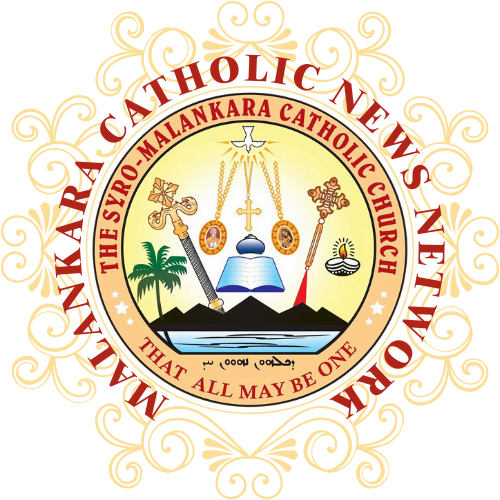“A Final Benediction”: Thousands Bid Farewell to Pope Francis at St. Peter’s Basilica
Vatican City – 23 April 2025
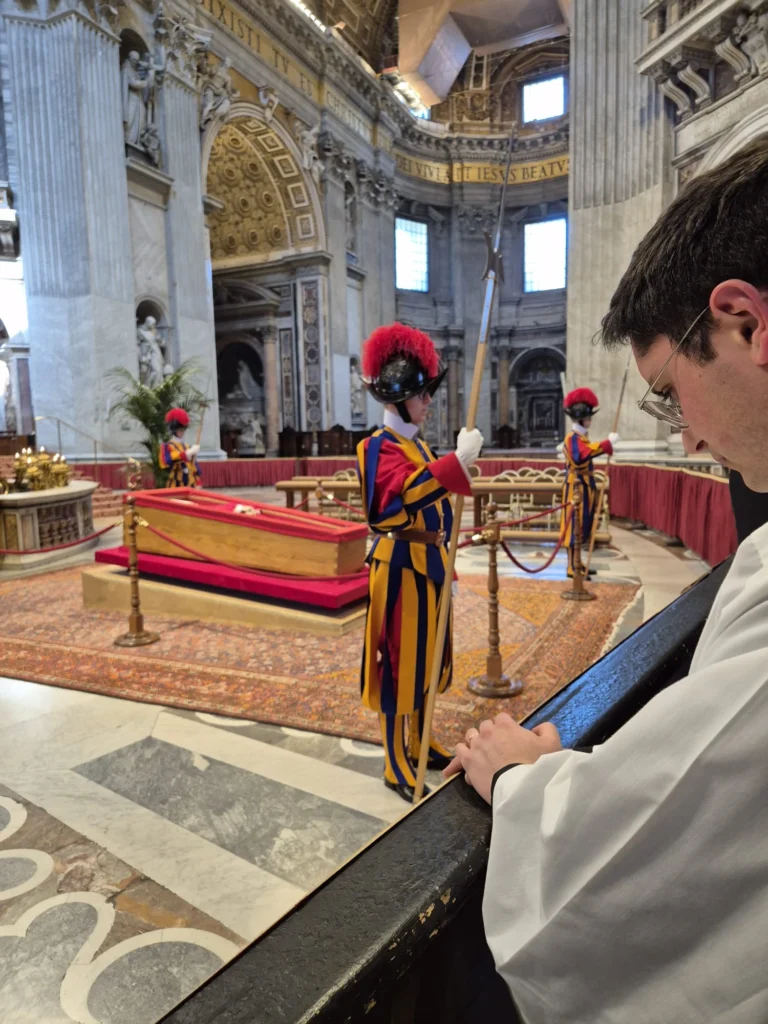
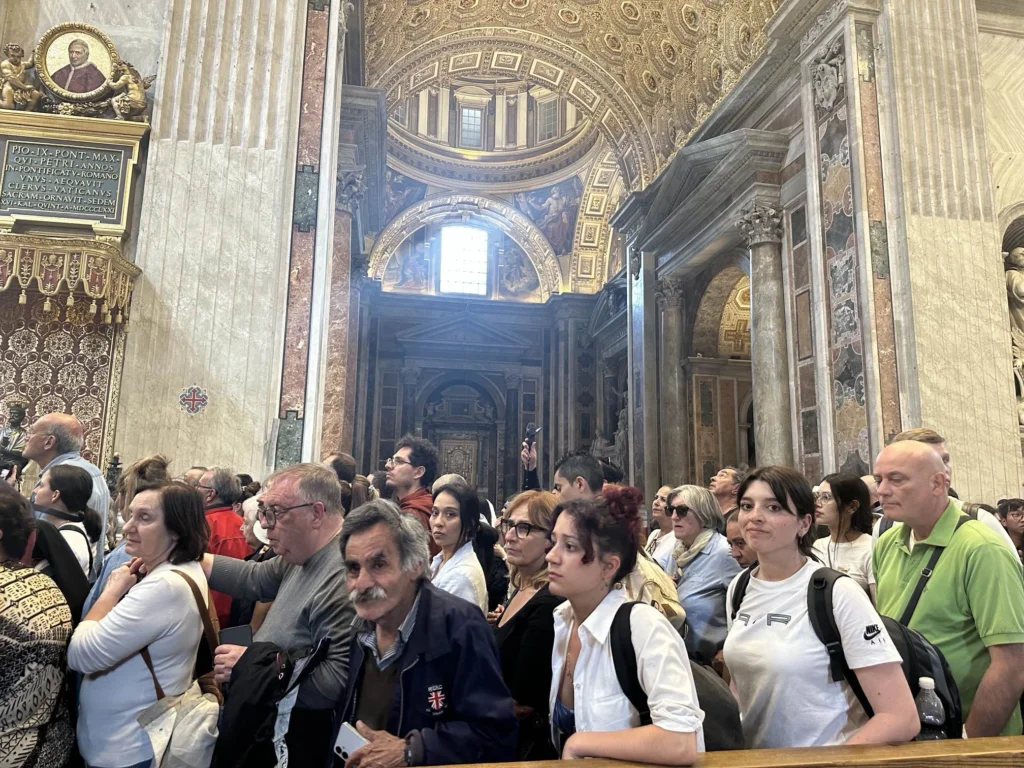
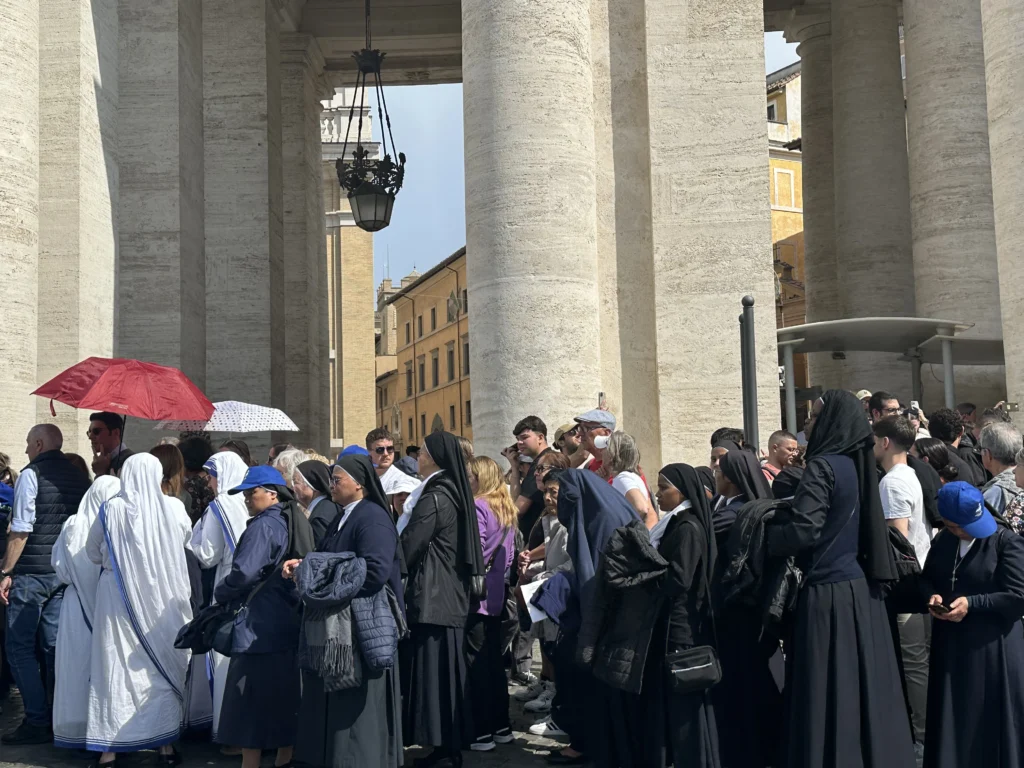
Under the Roman sun and in the shadow of St. Peter’s Basilica, the faithful waited—not in haste, but in devotion. On Wednesday, thousands of Catholics from across the world stood in line for hours, some praying the Rosary, others singing hymns, as they moved slowly toward the Basilica’s open doors to say a final goodbye to Pope Francis.
It was the first day of public viewing, and the turnout was vast—so much so that Vatican officials are considering extending the hours past midnight to accommodate the continuous stream of mourners. The line, stretching deep into St. Peter’s Square, bore witness to the Pope’s enduring bond with his people—a shepherd who had walked close to the flock, and now lies at rest among them.
Once inside, each pilgrim stepped forward in silence to pause before the open casket, placed before the main altar—in the very place where Pope Francis had celebrated countless Masses, just steps from the tomb of St. Peter. There, beneath the great dome, red vestments clothed his body, the bishop’s mitre resting on his head, and a rosary in his hands—a quiet testimony to a life woven in prayer.
Four members of the Swiss Guard, in full dress, stood vigil beside the casket. They guarded not just a coffin, but a legacy.
The late Holy Father will lie in state until Friday at 7:00 PM, after which his coffin will be sealed in a private rite led by Cardinal Kevin Farrell, in preparation for the Funeral Mass on Saturday, 26 April, at 10:00 AM Vatican Time (1:30 PM IST).
But for now, the people keep coming—old and young, religious and lay, locals and pilgrims. Each carries their own story, their own prayer, their own silent “thank you.”
This farewell is not loud, but it is vast.
Not hurried, but holy.
A final benediction—not from him to them, but from them to him.
Cardinals Approve Novemdiales Programme in Second General Congregation
Vatican City – 23 April 2025
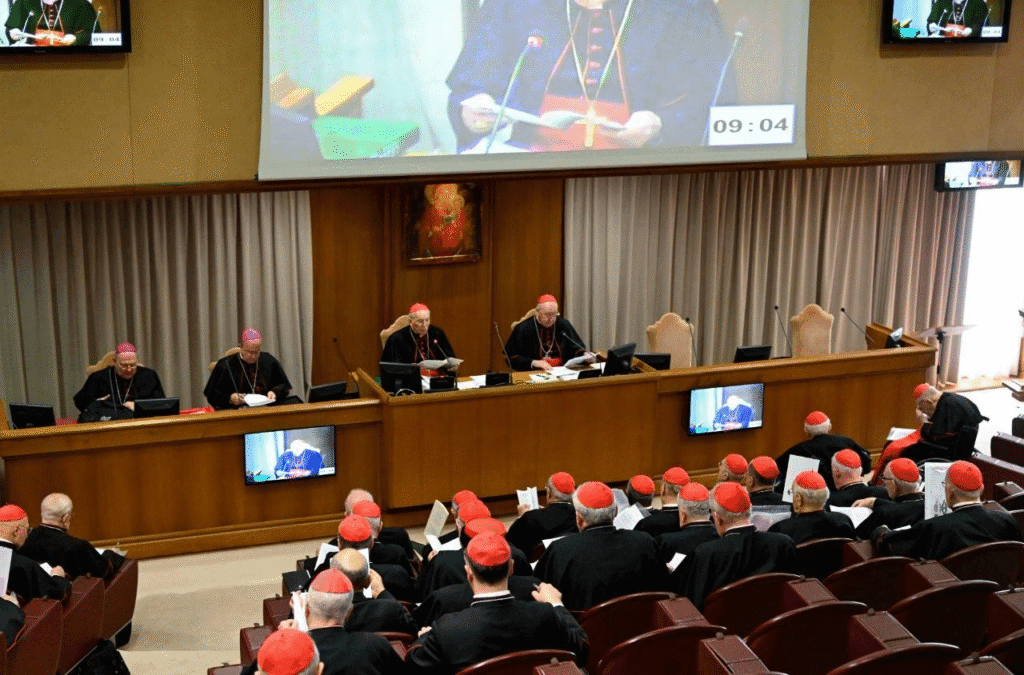
In the quiet confines of the Synod Hall, beneath frescoes and silence, the College of Cardinals reconvened on Wednesday afternoon for the second General Congregation, as the Church continues its solemn course through the days following the death of Pope Francis.
The meeting, which began at 5:00 PM and concluded by 6:30 PM, opened with the invocation “Veni, Sancte Spiritus”—a fitting prayer for a Church seeking clarity and consolation in the shadow of loss.
According to the Holy See Press Office, 103 cardinals were present. Those who had not participated in the first congregation on Tuesday were officially sworn in.
Foremost among the items approved was the programme for the Novemdiales—the traditional nine-day period of mourning, observed through liturgies, Masses, and communal prayer. This ancient practice, rooted in Roman custom and Christian hope, is now entrusted to the global Church as it offers its last gifts of prayer for the soul of the late pontiff.
The Novemdiales is not only a time of mourning, but a liturgical procession of memory—a reminder that the Church prays even after it weeps.
During the congregation, the cardinals also confirmed that all beatifications and canonisations are suspended until a new Pope is elected, in accordance with Universi Dominici Gregis, the constitution that guides the Church through the sede vacante.
The previously selected three-member commission—drawn by lot to assist the Camerlengo, Cardinal Kevin Farrell—remains in place. These are:
- Cardinal Pietro Parolin (Episcopal Order)
- Cardinal Stanisław Ryłko (Presbyteral Order)
- Cardinal Fabio Baggio (Diaconal Order)
This commission rotates every three days and ensures the temporal governance of the Church continues with fidelity and prudence.
Meanwhile, the faithful continue to gather in great number. As of 7:30 PM on Wednesday, more than 20,000 people had entered St. Peter’s Basilica to pray before the open casket of Pope Francis, resting near the tomb of the Apostle Peter.
The next General Congregation will be held on Thursday morning at 9:00 AM, as the cardinals proceed in prayer and discernment, not yet to choose—but to remember, to govern, and to prepare.
Tomb of Pope Francis Being Prepared at Basilica of St. Mary Major
Rome – 23 April 2025
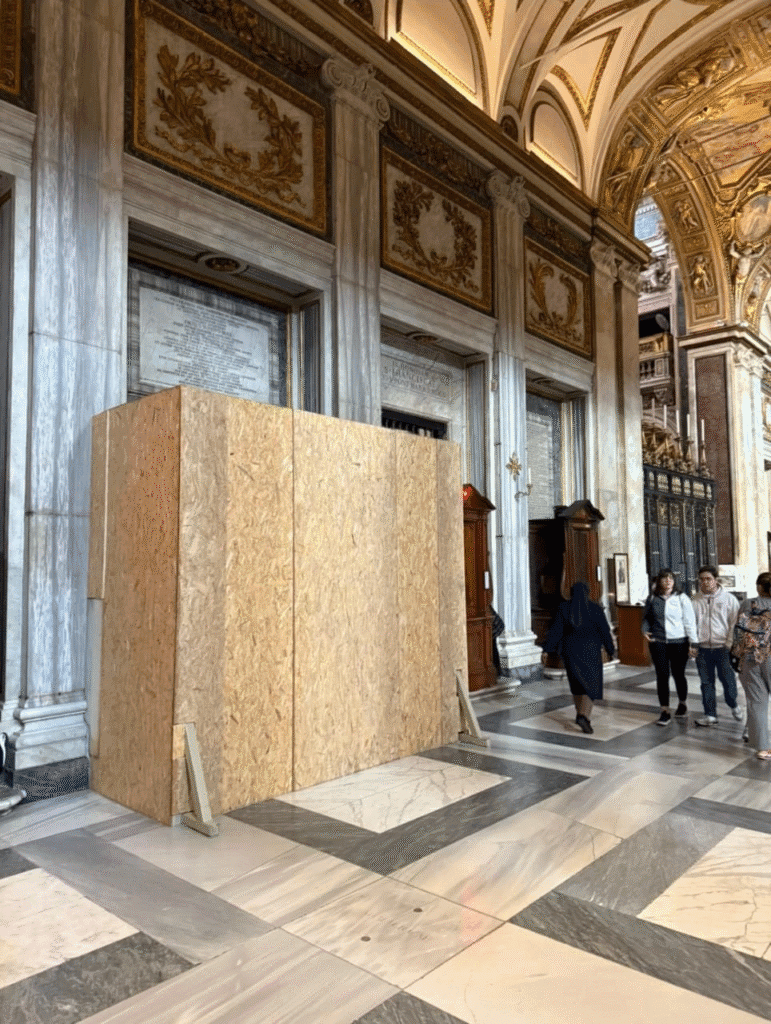
Even as thousands gather in St. Peter’s Basilica to bid their final farewell, quiet preparations are underway just across the city—at the Basilica of St. Mary Major, where the body of Pope Francis will be laid to rest after Saturday’s funeral.
Visitors to the basilica on Wednesday witnessed the beginnings of this sacred work: construction of the tomb that will receive the earthly remains of the Holy Father. Nestled between the Pauline Chapel, home to the revered icon Salus Populi Romani, and the Sforza Chapel, the tomb will be placed in the ground, in keeping with the Pope’s explicit testamentary request.
He asked for no monument, no grandeur—just a simple resting place marked with a single word:
Franciscus.
It is here, in one of Rome’s four major papal basilicas, that the Pope who led with mercy and walked among the poor will be buried. The basilica, completed in its present form in 1743, stands as a beacon of Marian devotion, a sanctuary Pope Francis visited over 100 times during his pontificate—before and after every apostolic journey, and even just days before his passing, in a quiet pilgrimage unknown to the world at the time.
With this burial, Pope Francis becomes the eighth pontiff to be laid to rest in Santa Maria Maggiore, joining a line that stretches from Pope Honorius III in the 13th century to Pope Clement IX in the 17th.
The basilica, often called Our Lady of the Snows, is not merely a site of architectural splendour. It is a house of prayer, where Mary, the Protectress of the Roman People, watches over her children. And now, she will also watch over a Pope who loved her dearly.
In stone and soil, a final act of faith unfolds.
In silence and devotion, the Church prepares to commend him to rest.
Not beneath a dome, but beneath the Mother’s mantle.
Pope Francis’ Coffin to Be Sealed on Friday in St. Peter’s Basilica
Vatican City – 23 April 2025
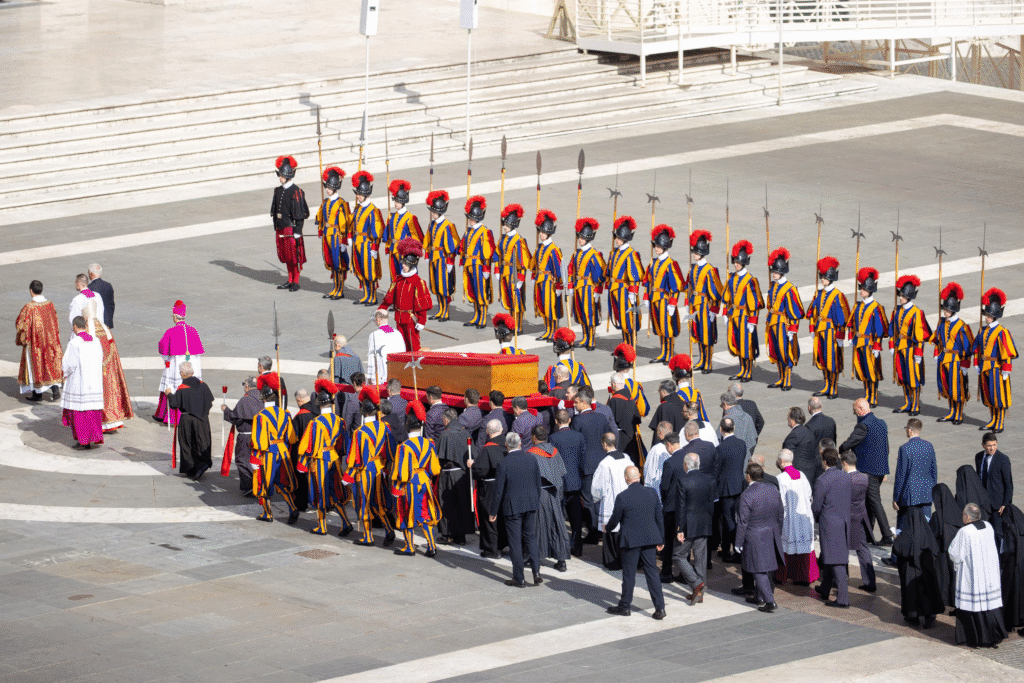
In a moment steeped in tradition and sacred symbolism, the coffin of Pope Francis will be formally sealed on Friday, 25 April, at 8:00 PM Vatican Time (11:30 PM IST) in St. Peter’s Basilica, the Vatican has announced.
Cardinal Kevin Farrell, Camerlengo of the Holy Roman Church, will preside over the solemn rite, held in accordance with the Ordo Exsequiarum Romani Pontificis—the official order of funeral rites for the Roman Pontiff. The announcement was made by Monsignor Diego Ravelli, Master of Pontifical Liturgical Celebrations, confirming that the ceremony will take place privately, in the presence of Church dignitaries and Vatican officials.
This rite, though closed to the public, holds profound weight. It marks the final earthly moment of preparation before Pope Francis’ body is taken to Santa Maria Maggiore, the basilica he so dearly loved, for burial following the funeral Mass on Saturday.
In keeping with the wishes outlined in his testament, Pope Francis’ coffin is simple, wooden, and unembellished, placed nearly at floor level during the days of public veneration—a reflection of the humility that defined his papacy.
As tradition dictates, during the sealing rite:
- A brief record of his pontificate, known as a Rogito, will be placed within the coffin.
- Sacred objects, including medals and a sealed document, may be included.
- The coffin will then be enclosed and prepared for its final interment.
Though hidden from view, the ritual speaks clearly to the faithful: the Church honours her shepherd with reverence, not fanfare. In silence and ritual, Pope Francis is commended once more to the Lord.
The sealing will precede the Funeral Mass on Saturday, 26 April, at 10:00 AM Vatican Time (1:30 PM IST) in St. Peter’s Square, after which his body will be taken to the Basilica of St. Mary Major for burial.
In this sacred interval, the world pauses again—not for a spectacle, but for a prayer.
From Pattom to Peter’s Tomb: Cardinal Cleemis Present in Rome for Pope Francis’ Final Farewell
Vatican City – 23 April 2025
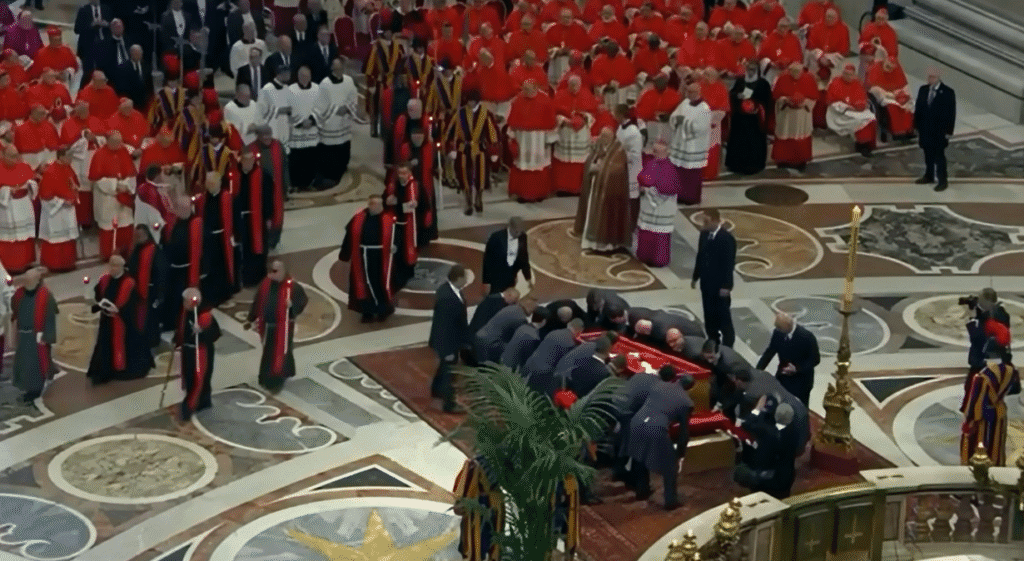
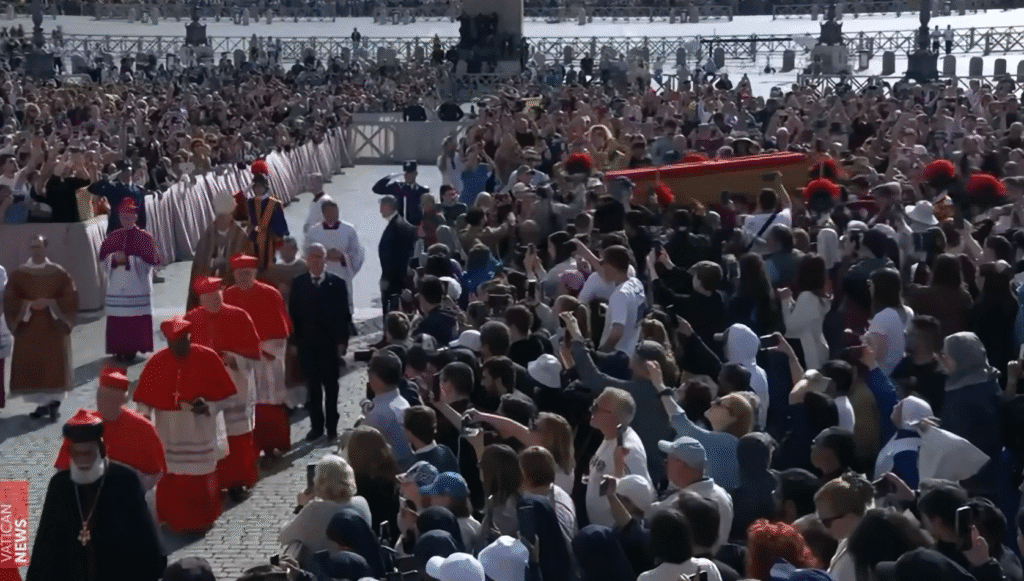
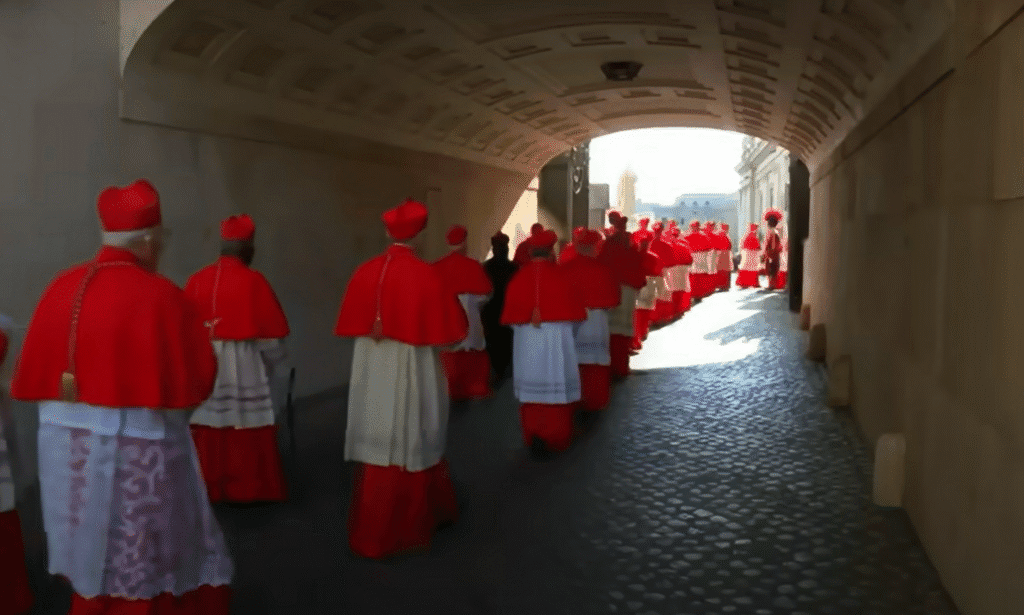
Just days after offering the incense prayer for Pope Francis at St. Mary’s Cathedral, Pattom, His Eminent Beatitude Cardinal Moran Mor Baselios Cleemis Catholicos has arrived in Rome, joining the Universal Church in honouring the late Holy Father.
After presiding over the memorial service in Trivandrum, where the cathedral stood steeped in silence and smoke of prayer, His Beatitude departed for the Eternal City—quietly, without announcement, as is his manner. And so it was that on Wednesday morning, as the coffin of Pope Francis was borne across St. Peter’s Square in the solemn translatio, Cardinal Cleemis was there—present among the cardinals and bishops who flanked the procession.
In one image, his face is turned gently toward the simple wooden casket. In another, he walks alongside fellow prelates as the Swiss Guards stood in formation. These were not gestures of diplomacy, but of fraternal fidelity—of a bishop who had shared communion with the Pope not only in Rome, but in prayer, in purpose, and in pastoral witness.
As the Pope of the Peripheries was brought to rest at the heart of the Church, Cardinal Cleemis carried with him the prayers of the Syro-Malankara Catholic Church, and of a people bound in spirit to the successor of Peter.
From Pattom to Peter’s tomb, it is not distance that defines the Church, but unity in love.
He came as a son of the East, to honour the Bishop of Rome.
And in that act, the Church was shown once more to be one.
“Pope of the Peripheries” Welcomed by the World: Thousands Gather to Bid Farewell to Pope Francis
Vatican City – 23 April 2025
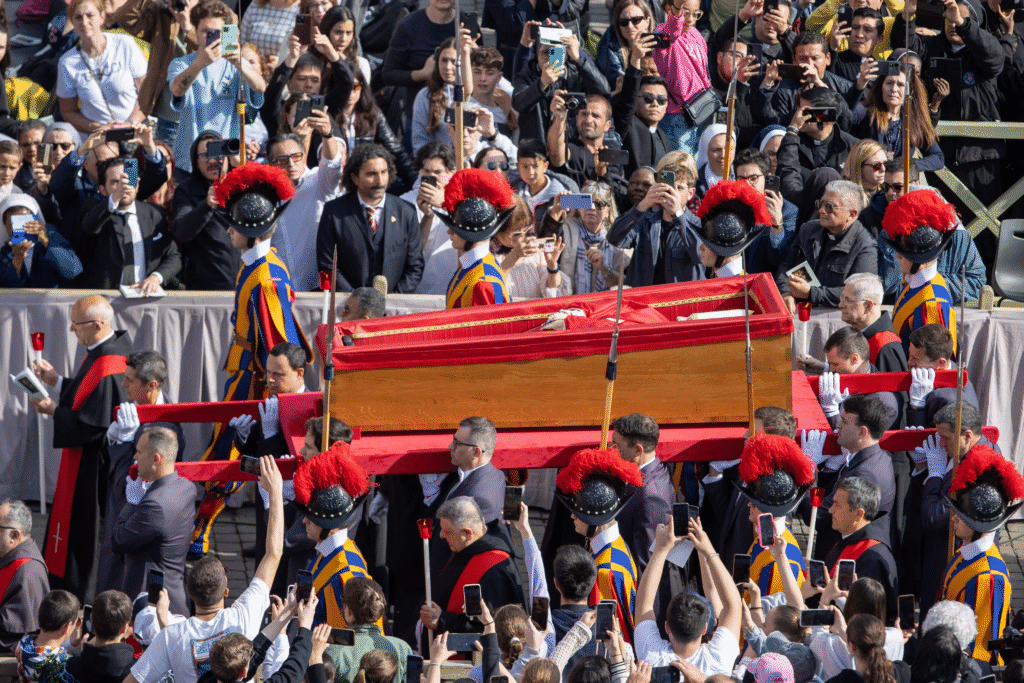
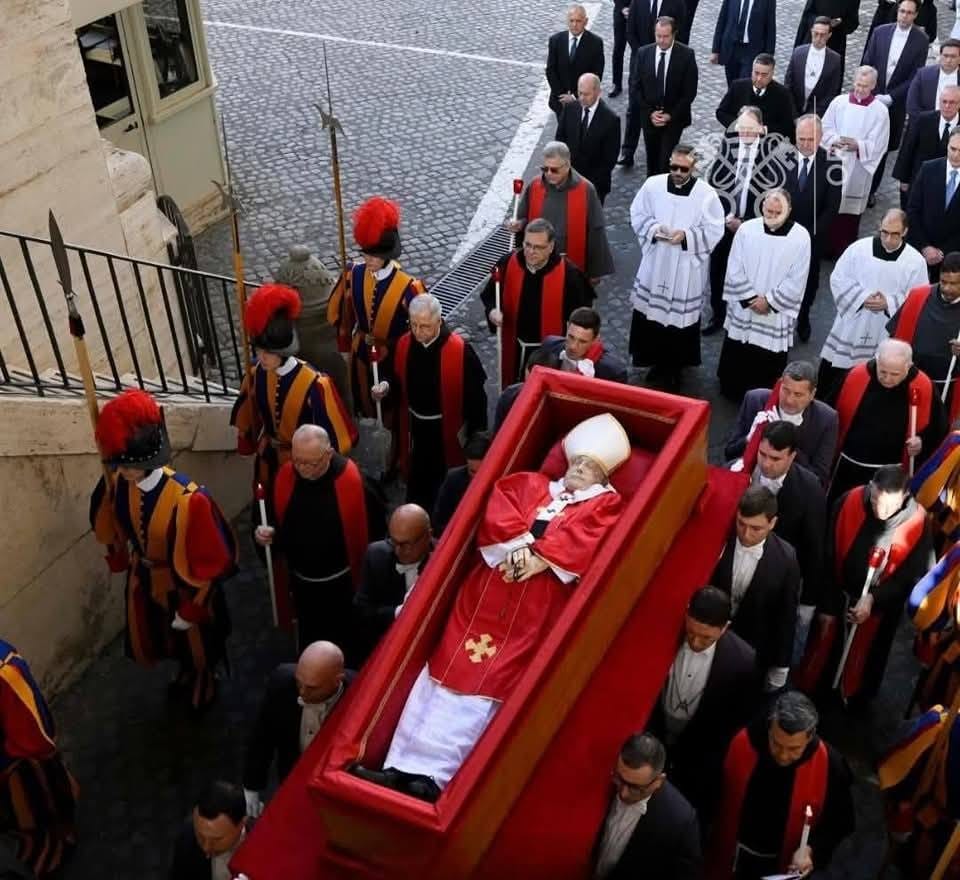


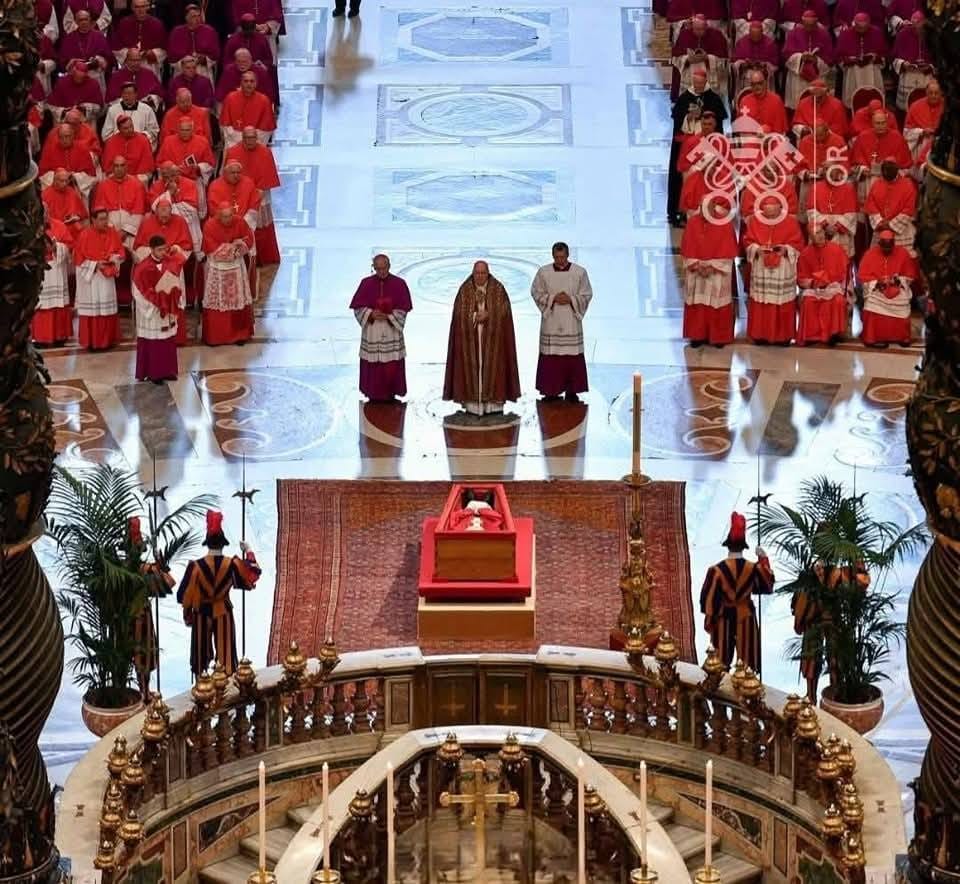


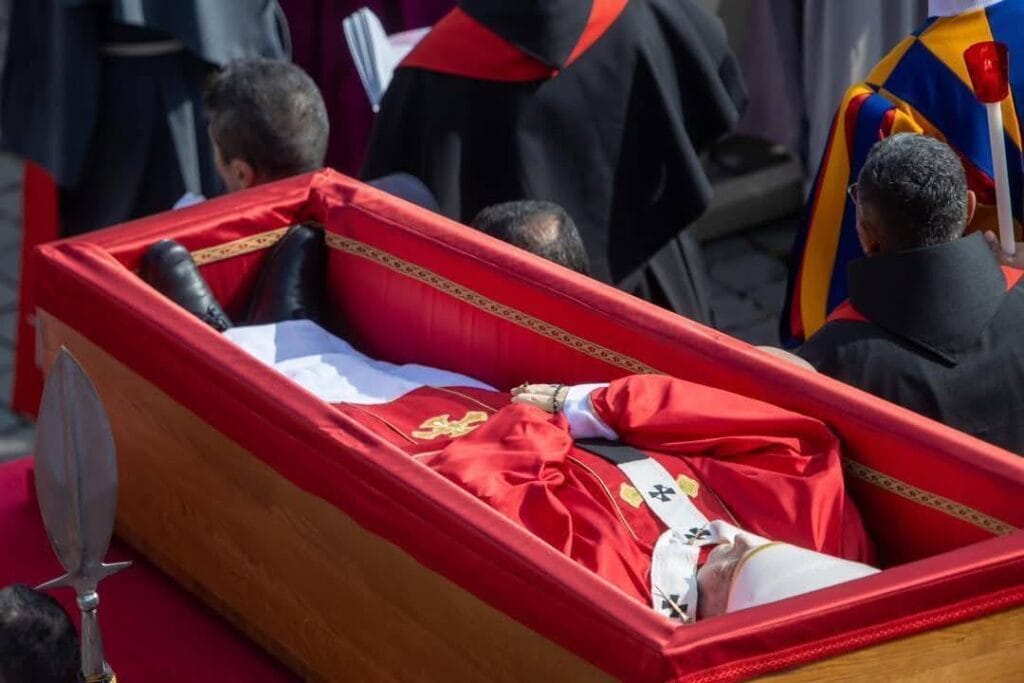
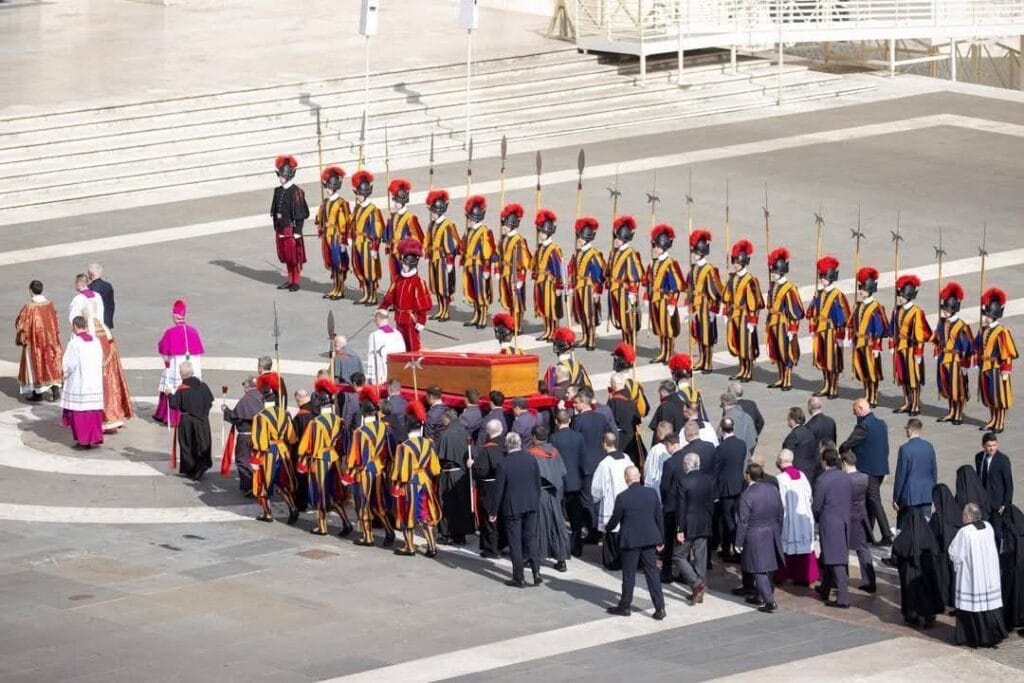

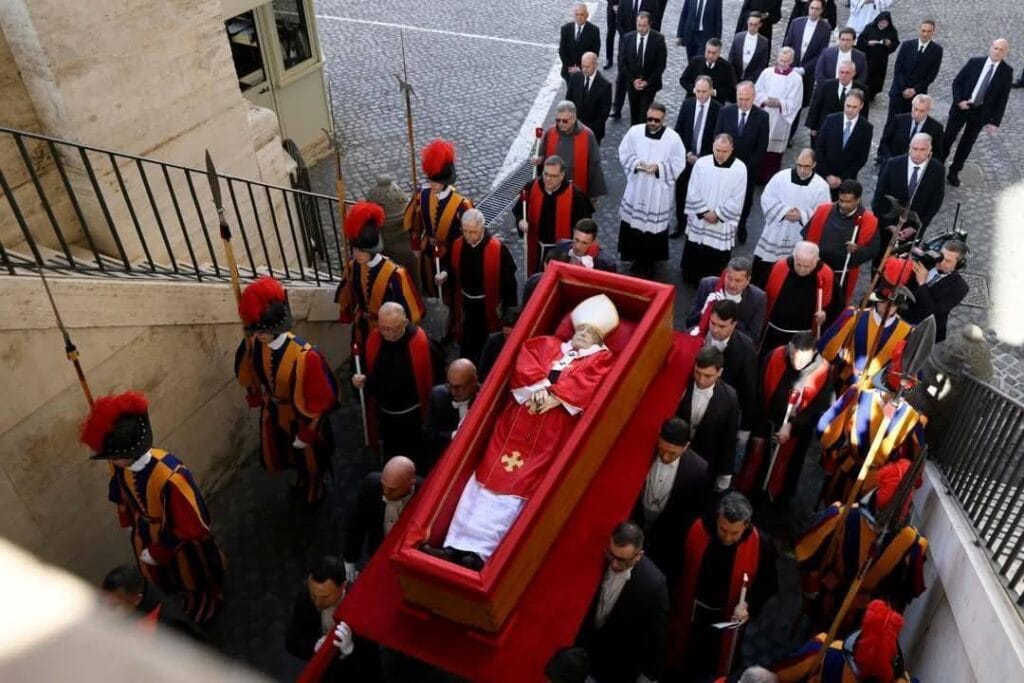
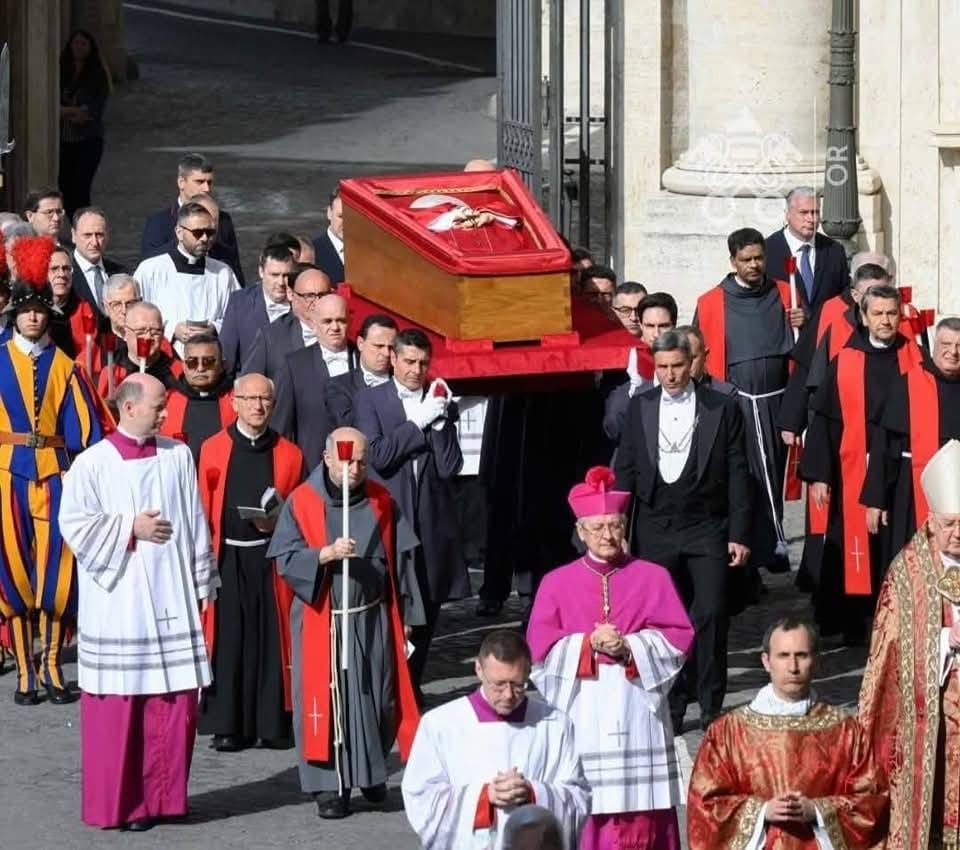
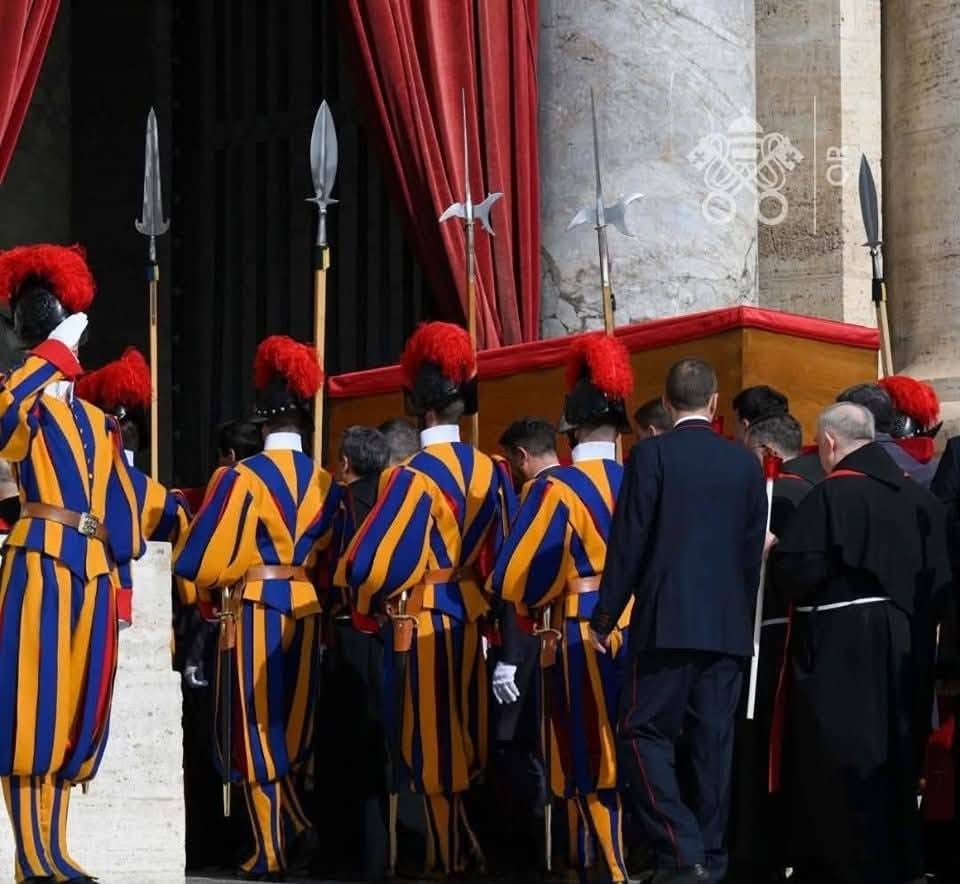

The morning sun rose over St. Peter’s Square, not in triumph, but in tenderness. At 9:00 AM local time, the coffin of Pope Francis was carried in solemn procession from Casa Santa Marta to St. Peter’s Basilica, marking the beginning of the public farewell to a shepherd who lived simply and walked humbly with his flock.
The rite, known as the translatio, began with prayer in the private chapel where Pope Francis had passed from this life. From there, the sediari pontifici—the bearers of the ancient papal throne—now shouldered a humbler weight: a plain wooden coffin, resting nearly at ground level, just as he had asked.
Accompanied by Swiss Guards in full ceremonial formation, cardinals, bishops, and Vatican officials, the procession crossed the square in reverent silence. Some among the 20,000 mourners gathered wept openly. Others clasped rosaries or raised tearful eyes as the coffin passed.
The crowd was global. Their faces diverse. But their prayer was one.
By 11:00 AM, the doors of the basilica opened, and the faithful began their slow, steady procession into the heart of Christendom. There, before the altar, the coffin of Pope Francis now rests—unadorned, quiet, and utterly close to the people. Pilgrims pause briefly—no lingering, no spectacle—just a moment of stillness, of prayer, of farewell.
He lies in state not on a throne, but on a modest wooden platform, almost at floor level—once more choosing nearness over height, presence over pageantry.
On Friday at 8:00 PM, Cardinal Kevin Farrell, as Camerlengo of the Holy Roman Church, will preside over the ritual sealing of the coffin, a rite reserved for popes and carried out with solemn precision. Until then, the faithful will continue to pass through the Basilica in quiet waves—one Church, grieving and grateful.
The Funeral Mass will take place on Saturday, 26 April, at 10:00 AM Vatican Time (1:30 PM IST) in St. Peter’s Square, after which the body of Pope Francis will be taken to St. Mary Major Basilica—his chosen place of burial.
He was called the “Pope of the peripheries.”
Today, the whole world has drawn to the centre—to Rome—not in pursuit of power, but in remembrance of mercy.
“Don’t Forget to Pray for Me”: Rosary for Pope Francis Led by Cardinal Re in St. Peter’s Square
Vatican City – 23 April 2025

As twilight bathed the colonnades of St. Peter’s Square in soft gold, the Church gathered in silence and supplication. Thousands of faithful—religious sisters, priests, pilgrims, and lay faithful—stood together on Tuesday evening, lifting their voices in the ancient rhythm of the Rosary, offered for the repose of Pope Francis.
The prayer was led by Cardinal Giovanni Battista Re, Dean of the College of Cardinals, who will also preside over the Holy Father’s funeral on Saturday. Before beginning the Rosary, the Cardinal reminded all gathered of a truth that pierces through the veil of grief:
“Death is not a door that closes, but rather the entrance to the heavenly Jerusalem, where mourning is turned into dancing and the garment of grief into a robe of joy.”
The Rosary focused on the Glorious Mysteries—resurrection, ascension, the outpouring of the Spirit—each bead echoing with the faith that shaped Pope Francis’ life and the hope he carried for the world.
As the crowd prayed, it was impossible not to recall the Pope’s familiar appeal at the end of so many of his speeches and blessings:
“Please, don’t forget to pray for me.”
Now, in death, the Church has not forgotten. It remembers in its most Catholic form—through litany and silence, through mystery and communion.
“It is the entire flock of Christ, the Good Shepherd, that prays for Pope Francis,” Cardinal Re affirmed.
This Rosary marks just one of several liturgical moments leading to Saturday’s Funeral Mass in St. Peter’s Square, and the entombment of the Holy Father at St. Mary Major Basilica.
In this sacred pause between death and burial, the Church speaks most powerfully—not through declarations, but through devotion. And in that devotion, the voice of Pope Francis lingers: gentle, unpretentious, and faithful.
His Beatitude Cardinal Baselios Cleemis Departs for Rome to Attend the Funeral of Pope Francis
Pattom, Trivandrum – 22 April 2025



As the bells of St. Mary’s Major Archbishop’s Cathedral tolled in quiet mourning, His Eminent Beatitude Cardinal Moran Mor Baselios Cleemis Catholicos, Major Archbishop-Catholicos of the Syro-Malankara Catholic Church, departed for Rome to attend the funeral of His Holiness Pope Francis, the 266th successor of St. Peter.
The air carries sorrow, but not despair—grief, but seasoned with faith. For in these days, as the Universal Church prepares to bid farewell to the Bishop of Rome, we witness not only the ending of a life, but the culmination of a vocation lived in mercy, humility, and Marian devotion.
On Wednesday, 23 April, the body of Pope Francis will be transferred from Casa Santa Marta to St. Peter’s Basilica, where the faithful may come and pray beside him—silent pilgrims to a quiet shepherd.
Then, on Saturday, 26 April 2025, at 10:00 AM Vatican Time (1:30 PM IST), the Funeral Mass will be offered in St. Peter’s Square, presided over by Cardinal Giovanni Battista Re, Dean of the College of Cardinals. Concelebrating with him will be Patriarchs, Cardinals, Archbishops, Bishops, and clergy from across the globe—a living image of the communion which Pope Francis not only preached, but lived: a Church of bridges, not walls.
Among them stands His Beatitude Cardinal Cleemis, bearing in his heart the prayers of the Syro-Malankara Catholic Church, and in his presence, our communion with the See of Peter.
The funeral will conclude with the ancient rites of the Ultima commendatio and Valedictio, after which the body of Pope Francis will be brought to St. Mary Major Basilica—his chosen place of rest, in the shadow of Salus Populi Romani, the icon he so often venerated.
Following the funeral, the Church will enter the Novemdiales—nine days of prayer for the repose of his soul. Across our parishes, monasteries, and homes, we, too, will gather in remembrance, offering Holy Qurbono, incense, and prayer.
In mourning, we remain united. In prayer, we remain strong. And in gratitude, we commend Pope Francis—a servant of servants—to the embrace of the Eternal High Priest.
The Body of Pope Francis to Lie in State Until Saturday’s Funeral
Vatican City – 22 April 2025

The Church universal enters these days with the weight of sorrow and the fragrance of faith. In a gesture echoing centuries of sacred tradition, the mortal remains of His Holiness Pope Francis will be transferred on Wednesday to St. Peter’s Basilica, where he shall lie in state until his funeral on Saturday, 26 April 2025, at 10:00 AM Vatican Time (1:30 PM IST).
Cardinal Giovanni Battista Re, Dean of the College of Cardinals, will preside over the funeral Mass in St. Peter’s Square. Concelebrating with him shall be a gathering of Patriarchs, Cardinals, Archbishops, Bishops, and priests from across the continents—an image of the universality Pope Francis so often evoked in word and deed.
The Holy Eucharist will culminate in the Ultima commendatio and Valedictio, ushering in the sacred days of Novemdiales—nine days of mourning, prayer, and daily Holy Qurbana for the repose of the soul of the Bishop of Rome.
As per the Holy See’s announcement, the Pope’s body will be solemnly carried from the Chapel of the Casa Santa Marta to St. Peter’s Basilica on Wednesday, 23 April, led by Cardinal Kevin Farrell, Camerlengo of the Holy Roman Church. This rite of translation will begin with prayer at 9:00 AM Vatican Time (12:30 PM IST), journeying through Santa Marta Square, Square of the Roman Protomartyrs, and finally through the Arch of the Bells into St. Peter’s Square.
At the Altar of the Confession, the Liturgy of the Word will be offered before the faithful are permitted to come forward—one by one—to pray beside the body of the late Pope.
Following Saturday’s funeral, his body will be carried to the Basilica of St. Mary Major for entombment—a fitting resting place for a pontiff so deeply devoted to the Mother of God.
Symbols of Simplicity and Spirit: Pope Francis Lies in State at Casa Santa Marta
Vatican City – 22 April 2025
The room is still. The light is subdued. And in that silence, theology speaks—not through words, but through symbols.
Photographs released earlier today from the Vatican show Pope Francis lying in an open wooden coffin within the chapel of Casa Santa Marta, the residence he chose in life and now, in death, continues to sanctify by his presence.
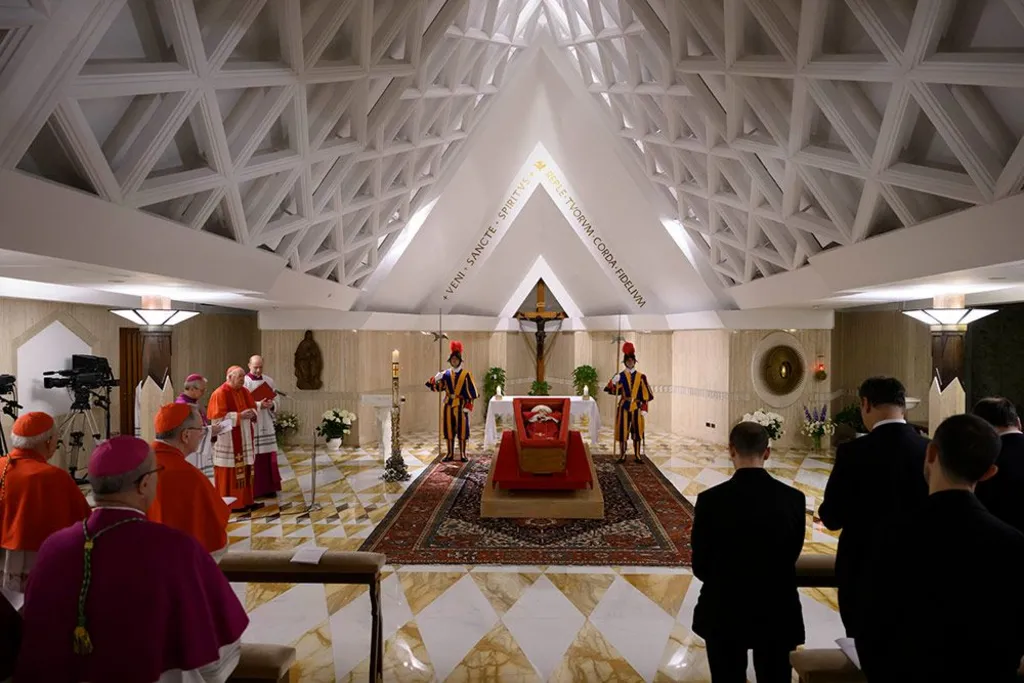
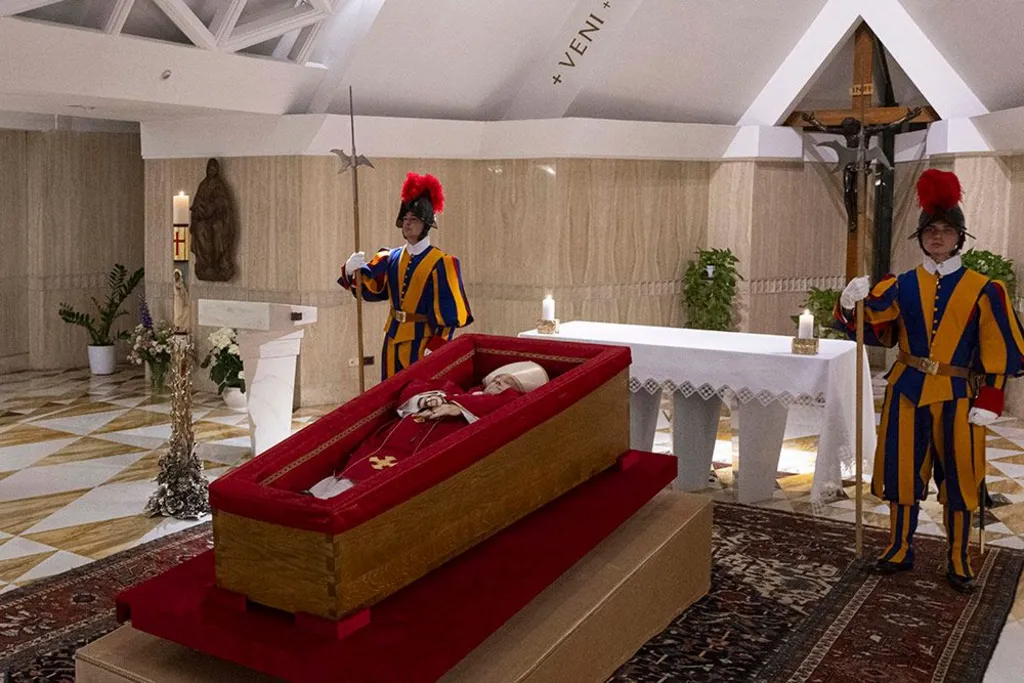


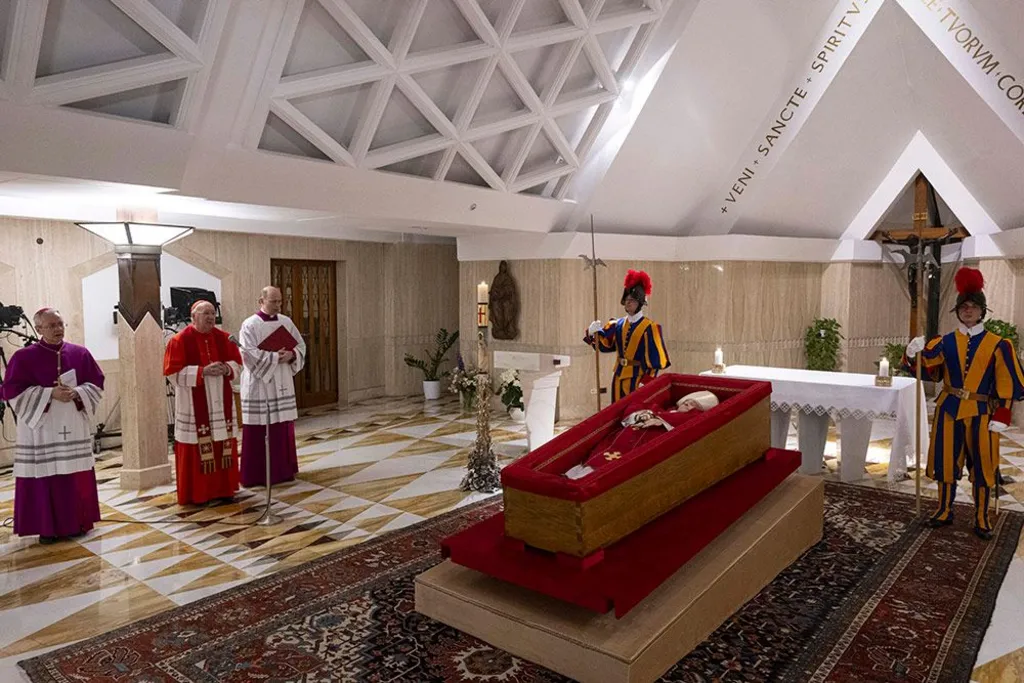

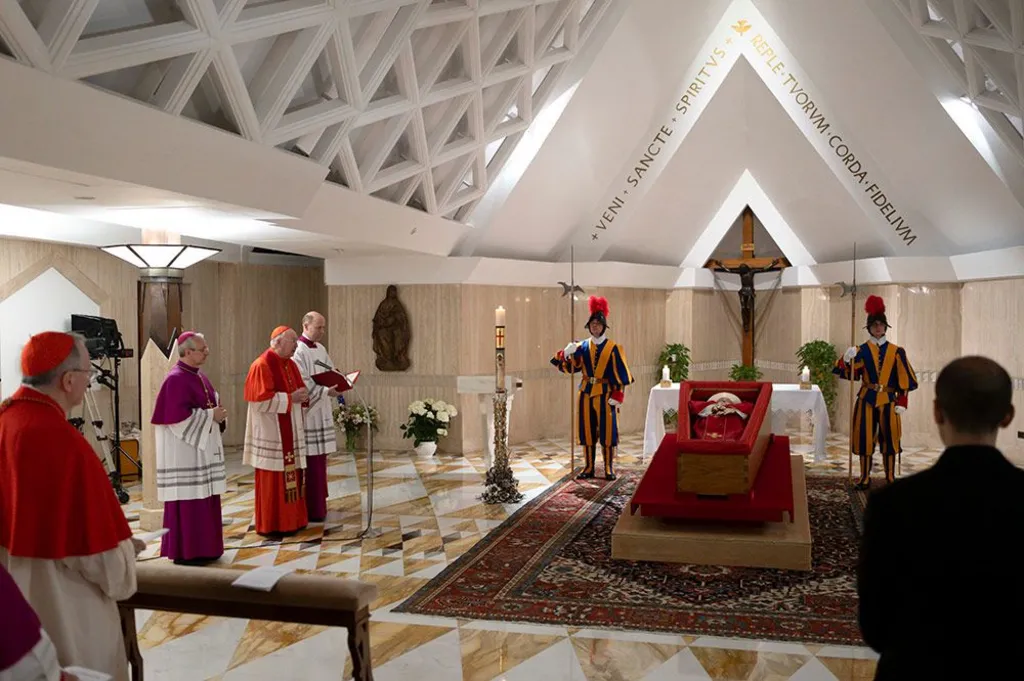
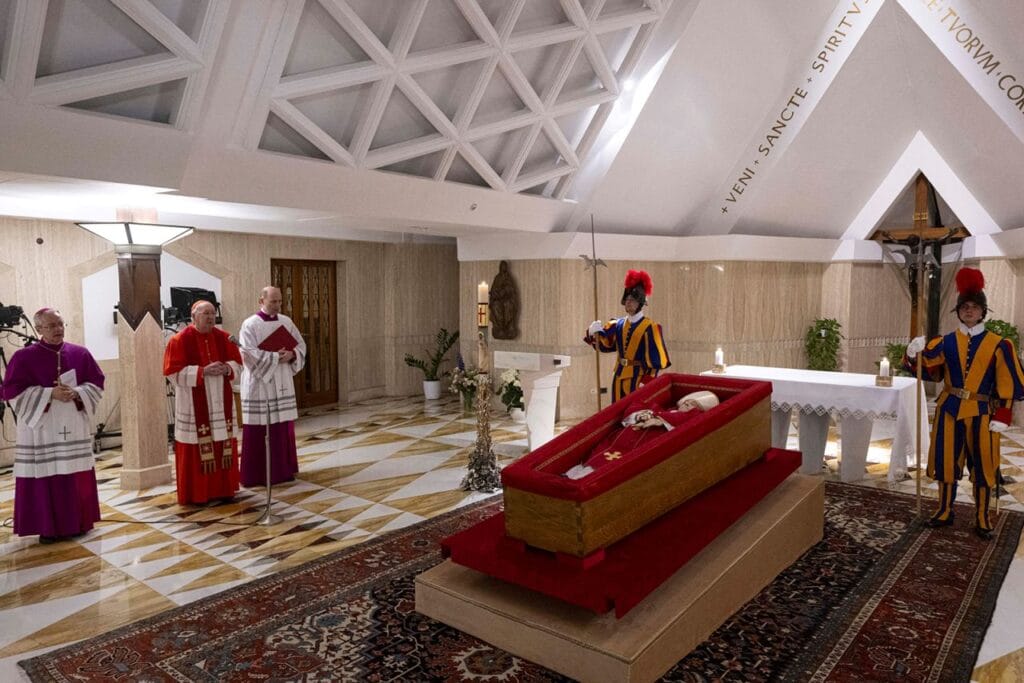
Dressed in red liturgical vestments, symbolic of the blood of the martyrs and the fire of Pentecost, Pope Francis holds a rosary in his hands and wears the papal mitre—a white headdress signifying episcopal authority. Notably, he is adorned with a simple silver ring, not the ornate Fisherman’s Ring, which he rarely wore outside solemn occasions. That ring, the traditional seal of papal authority, is to be ritually destroyed by Cardinal Kevin Farrell, Camerlengo of the Holy Roman Church, to mark the end of his office.
Around the coffin stand members of the Swiss Guard, the Pope’s traditional protectors since 1506. Their presence here is not merely ceremonial; it is a quiet honour guard of fidelity, history, and mourning.
Behind him, etched in Latin upon the chapel ceiling, are the words:
“Veni Sancte Spiritus, reple tuorum corda fidelium”
(Come, Holy Spirit, fill the hearts of your faithful)—a prayer not only for the next conclave, but for the world Pope Francis loved and served.
The symbolism continues in the very structure of the chapel. Triangular patterns in the ceiling and floor tiles reflect the mystery of the Holy Trinity, at the heart of Christian belief and the liturgical life of the Church.
One particular departure from past papal customs is both deeply personal and profoundly theological: Pope Francis lies in a single wooden coffin, as he had requested, rather than the traditional three-nested cypress, lead, and oak. This return to simplicity mirrors his entire pontificate—a life not marked by grandeur, but by grace.
Unlike his predecessors who were laid out upon raised platforms, Pope Francis rests within the coffin itself, open and visible to the faithful. In life, he was a Pope who lived close to the people. In death, he remains so.
He will remain in this chapel until Wednesday morning, when at 9:00 AM Vatican Time (12:30 PM IST), his body will be transferred in solemn procession to St. Peter’s Basilica, where the public may pay their respects ahead of his funeral on Saturday.
And so he lies—Franciscus. A shepherd of the peripheries, now surrounded by ancient rites, timeless symbols, and the prayers of a world in mourning.
General Congregations of Cardinals Begin in Vatican
Vatican City – 22 April 2025

In the hushed halls of the Synod, where centuries of faith have found voice, the College of Cardinals gathered on Tuesday morning for the first General Congregation since the death of Pope Francis. A moment of silent prayer opened the session, offering the repose of the Pope’s soul to the mercy of God.
Roughly sixty cardinals assembled for this solemn task—not merely of governance, but of discernment. As prescribed by the Apostolic Constitution Universi Dominici Gregis, they took the oath binding them to the laws of the sede vacante: a sacred pause in the papal office, filled not with absence but with preparation.
The Adsumus, an invocation to the Holy Spirit traditionally sung before councils and synods, was raised once again within those walls—words echoing through the ages, asking not for human brilliance but divine guidance.
Cardinal Kevin Farrell, Camerlengo of the Holy Roman Church, read aloud the spiritual testament of Pope Francis—an intimate document expressing the heart of a pontificate now come to rest.
Paragraphs 12 and 13 of Universi Dominici Gregis were proclaimed, setting forth the procedures for this interregnum and the approaching papal election. These statutes, born of wisdom and sanctity, now shape the days ahead.
The Congregation also confirmed the dates previously released:
- The ceremonial transfer of Pope Francis’ body to St. Peter’s Basilica will take place on Wednesday morning, 23 April,
- The funeral is to be held on Saturday, 26 April at 10:00 AM Vatican Time (1:30 PM IST) in St. Peter’s Square.
- The second General Congregation is scheduled for Wednesday afternoon, continuing the cardinals’ shared prayer and deliberation.
As part of the Novemdiales—the traditional nine days of mourning—the second memorial Holy Mass will be celebrated in St. Peter’s Square on Sunday, 27 April, presided over by Cardinal Secretary of State Pietro Parolin. From Monday onwards, these Masses will be held daily at 5:00 PM Vatican Time (8:30 PM IST).
To assist the Camerlengo in overseeing the Church during this period, a three-member commission of cardinals has been appointed by lot. Representing the three orders of the College, they are:
- Cardinal Pietro Parolin (Episcopal Order)
- Cardinal Stanisław Ryłko (Presbyteral Order)
- Cardinal Fabio Baggio (Diaconal Order)
This trio will serve for three days, to be succeeded in rotation by others, in accordance with the law of the Church.
As twilight descended upon the Vatican on Tuesday, the faithful were invited to gather once more—not in ceremony, but in supplication. A Rosary for the repose of Pope Francis was scheduled in St. Peter’s Square at 7:30 PM Rome Time (11:00 PM IST)—a reminder that the governance of the Church may be structured, but its soul is always prayer.
Steward of the Sede Vacante: Cardinal Kevin Farrell Now Oversees the Vatican
Vatican City – 22 April 2025

When the voice of the Shepherd falls silent, the Church does not collapse into confusion—it turns, with quiet solemnity, to ancient order. And now, during the interregnum known as “Apostolica Sedes Vacans”, the care of the temporal governance of the Vatican rests with Cardinal Kevin Farrell, appointed Camerlengo of the Holy Roman Church by Pope Francis in 2019.
Born in Dublin in 1947, Cardinal Farrell’s path took him through the University of Salamanca, the Pontifical Gregorian University, and into more than three decades of pastoral service in the United States, most notably as Bishop of Dallas. In 2016, Pope Francis entrusted him with a newly created Vatican department for the laity, family, and life, raising him to the cardinalate soon after.
Now, at the age of 77, his role has taken on global visibility. It was he who presided over the Rite of Ascertainment of Death on Monday evening, confirming the passing of the Holy Father and overseeing the placement of his body into the coffin—rituals that form part of his sacred duty.
The Camerlengo, under canon law, has a focused and highly structured responsibility. While he does not wield papal authority, he is entrusted with:
- Securing the Vatican, including placing seals on the Papal apartments
- Overseeing daily operations and financial matters
- Organising the conclave that will elect the next Pope
- And presiding over certain rites and ceremonies connected to the Pope’s death
During this period, no major Church decisions or doctrinal declarations are made—but the machinery of the Church continues to function with discipline and reverence, shepherded by procedures long sanctified by time.
Cardinal Farrell, known for his pastoral warmth and administrative clarity, has thus stepped into one of the most delicate phases in ecclesial life—not as a successor, but as a steward. The heart of the Church may mourn, but its body remains ordered, prayerful, and deeply attentive.
As preparations for Pope Francis’ funeral continue, and the College of Cardinals gathers for daily congregations, Cardinal Farrell will continue to guide the Vatican’s daily affairs—not in his own name, but in quiet service to the Church that awaits her next successor to Peter.
Seals Placed on Santa Marta: Rite of Death and Vigil of Silence
Vatican City – 22 April 2025

The hour was quiet. The prayers whispered. The rites precise. On the evening of Monday, 21 April, the Church confirmed with solemnity what the faithful had already received in sorrow: Pope Francis had fallen asleep in the Lord.
Within the ground-floor chapel of the Casa Santa Marta, the rite affirming the Pope’s death and the placing of his body in the coffin was conducted with both dignity and discretion. The official declaration of death was read aloud and validated by Cardinal Kevin Farrell, the Camerlengo of the Holy Roman Church. The ceremony, rich in symbolism and silence, lasted just under an hour.
This was no mere formality. It was a sacred act—marking the earthly conclusion of a papacy lived in service, simplicity, and trust in the mercy of God.
Later that evening, the ancient practice of placing seals was observed. The doors of the Papal Apartment on the third floor of the Apostolic Palace, long unoccupied by Pope Francis, and the residential suite on the second floor of the Casa Santa Marta, which he had humbly chosen as his home, were sealed. These acts, enshrined in apostolic tradition, ensure that no document, possession, or personal item is disturbed during the interregnum.
The sealing of doors is a visible gesture of an invisible truth: the sede vacante has begun. The See of Peter is empty. The Church now prays, watches, and prepares.
On Tuesday morning, the first General Congregation of Cardinals will convene, continuing the rhythm of tradition and discernment. Among the items on the agenda: the coordination of mourning rites and the final confirmation of funeral details, already set for Saturday, 26 April.
As candles flicker and prayers rise from chapels to squares, the Church enters into mourning—but not as those without hope. For the man who refused splendour has now stepped into glory, his doors sealed, his name already inscribed in the memory of the faithful.
Cardinal Farrell Presides Over Rite Confirming the Death of Pope Francis
Vatican City – 22 April 2025

In the hush of twilight, beneath the gentle lights of the Casa Santa Marta chapel, a final rite was carried out—solemn, ancient, and necessary. On Monday evening at 8:00 PM, Cardinal Kevin Farrell, Camerlengo of the Holy Roman Church, presided over the Rite of the Ascertainment of Death and the placement of Pope Francis’ body in the coffin.
The ceremony, conducted in quiet dignity, marked the definitive transition from earthly care to ecclesial memory. Gathered around were key figures who had shared the Pope’s final hours and responsibilities:
- Cardinal Giovanni Battista Re, Dean of the College of Cardinals
- Dr. Andrea Arcangeli and Dr. Luigi Carbone, Director and Deputy Director of the Directorate of Health and Hygiene
- Family members of the late Holy Father
As part of the rite, the official declaration of death was read aloud. Its words, though brief, echoed with gravity—the voice of the Church affirming what heaven already knew: that her shepherd had passed from labour to rest.
Dr. Andrea Arcangeli reiterated the cause of death: a stroke, followed by coma and irreversible cardiocirculatory collapse. His medical report, consistent with earlier statements, also noted the Pope’s history of acute respiratory failure, bronchiectasis, hypertension, and Type II diabetes.
There was no pomp, no spectacle—only the reverence of ritual, the clarity of canonical order, and the intimacy of farewell.
From this moment, the Church enters a sacred pause. The See of Peter is empty. And in this emptiness, there is expectation—not only for the election to come, but for the Church’s continual turning to prayer, to memory, and to hope.
India Mourns Pope Francis: Three Days of National Tribute and Kerala’s Unified Remembrance
New Delhi / Thiruvananthapuram – 22 April 2025
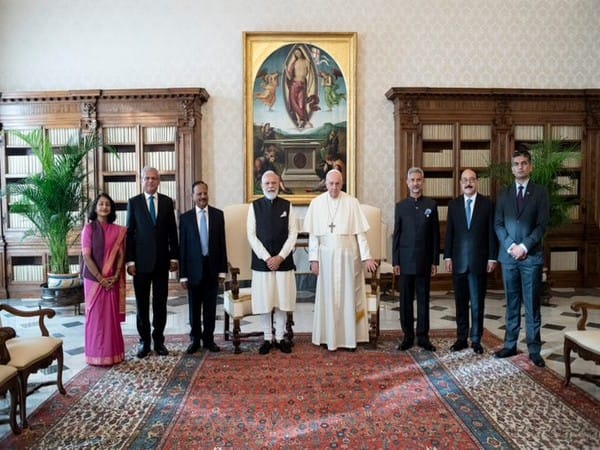
In a rare and solemn gesture, the Government of India has declared a three-day State Mourning in honour of Pope Francis, Supreme Pontiff of the Catholic Church, who passed away on 21 April 2025. The mourning will be observed on 22 and 23 April, and again on the day of the Holy Father’s funeral, set for Saturday, 26 April.
A statement from the Ministry of Home Affairs read:
“As a mark of respect, three-day State Mourning shall be observed throughout India… The national flag will be flown at half-mast on all buildings, and there will be no official entertainment during this period.”
Prime Minister Narendra Modi, offering heartfelt condolences, described Pope Francis as a “beacon of compassion, humility, and spiritual courage.” In a message shared on X (formerly Twitter), the Prime Minister recalled the Pope’s deep commitment to the suffering and marginalised, and their own meetings marked by shared reflections on inclusive development and global unity.
“His affection for the people of India will always be cherished,” the Prime Minister wrote.
“May his soul find eternal peace in God’s embrace.”
External Affairs Minister S. Jaishankar also expressed sorrow, calling Pope Francis “a kind leader whose compassion defined his papacy.”
Across Kerala, where the Catholic community shares deep historical and spiritual ties with the global Church, leaders from every political persuasion mourned the Pope’s death with remarkable unity.
Chief Minister Pinarayi Vijayan described Pope Francis as “an ardent advocate for the poor and marginalised”, while Speaker A N Shamseer reflected on the Pope’s “simplicity and compassion, which gave hope to millions.”
KPCC President K. Sudhakaran announced a three-day period of mourning within the party, cancelling all programmes and recalling the Pope’s humanism and moral clarity on issues ranging from climate justice to global peace.
Opposition Leader V D Satheesan noted the Pope’s last public Easter message, which remembered the suffering in Gaza, showing that “his heart remained with the afflicted until the very end.”
Union Minister George Kurian, BJP State President Rajeev Chandrasekhar, IUML leader P K Kunhalikutty, Congress veteran A K Antony, and CPI(M) State Secretary M V Govindan were among the many who spoke with reverence and gratitude, reflecting on a life lived “for the well-being of humanity.”
While words differ, the sentiment across India is unmistakable: Pope Francis was not only a religious figure, but a moral voice in a fractured world—one who reached beyond ecclesiastical walls to touch lives with kindness, courage, and disarming humility.
As the Church enters the Novemdiales, nine days of prayer and remembrance, India joins in mourning. The flag may hang low, but the memory of Pope Francis remains lifted high—in the hearts of the faithful, and in the quiet prayers of a nation.
Incense and Communion: Syro-Malankara Church Remembers Pope Francis in Pattom Cathedral
Pattom, Trivandrum – 21 April 2025
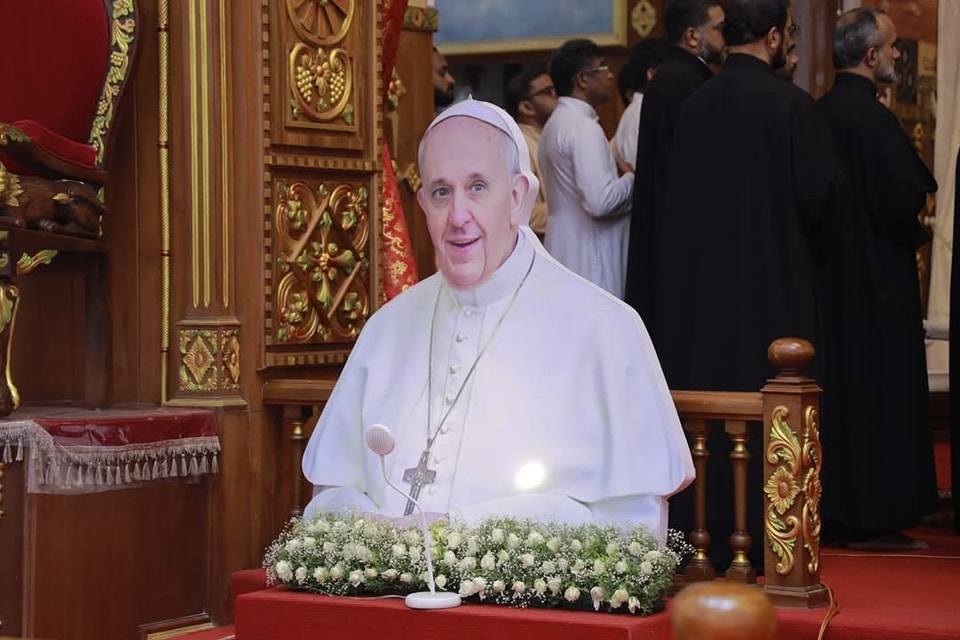
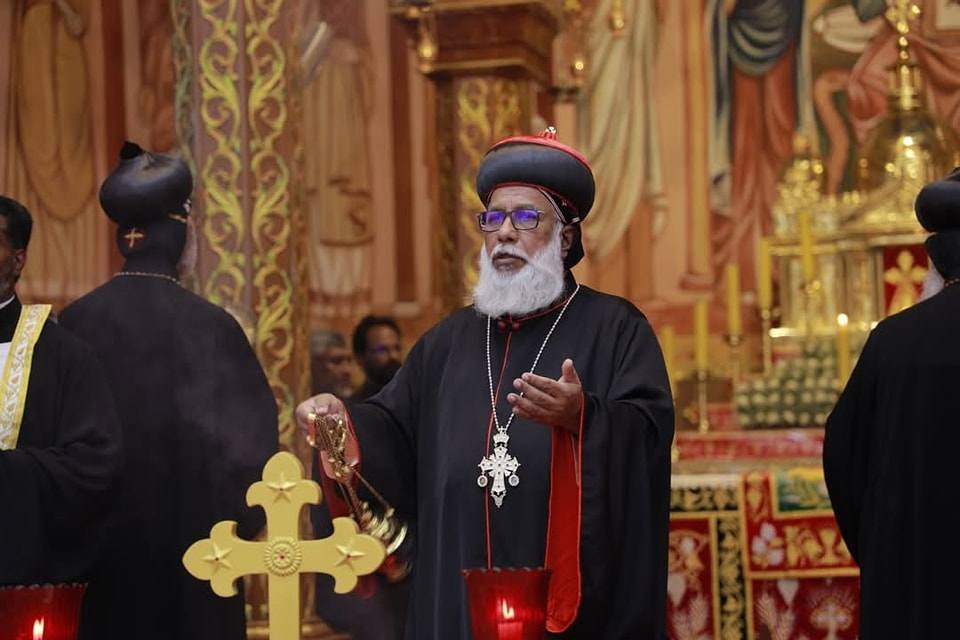
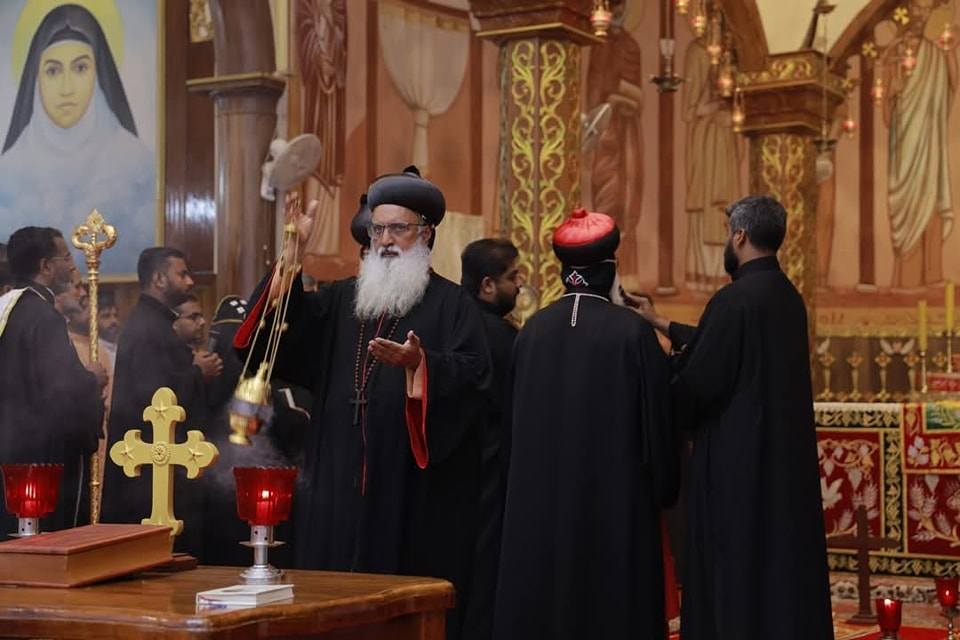
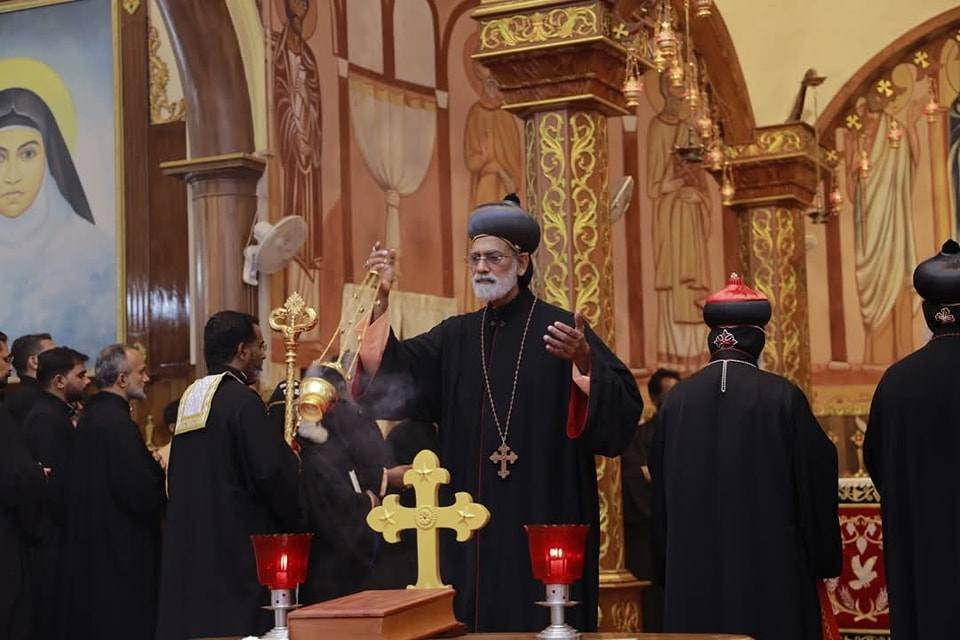
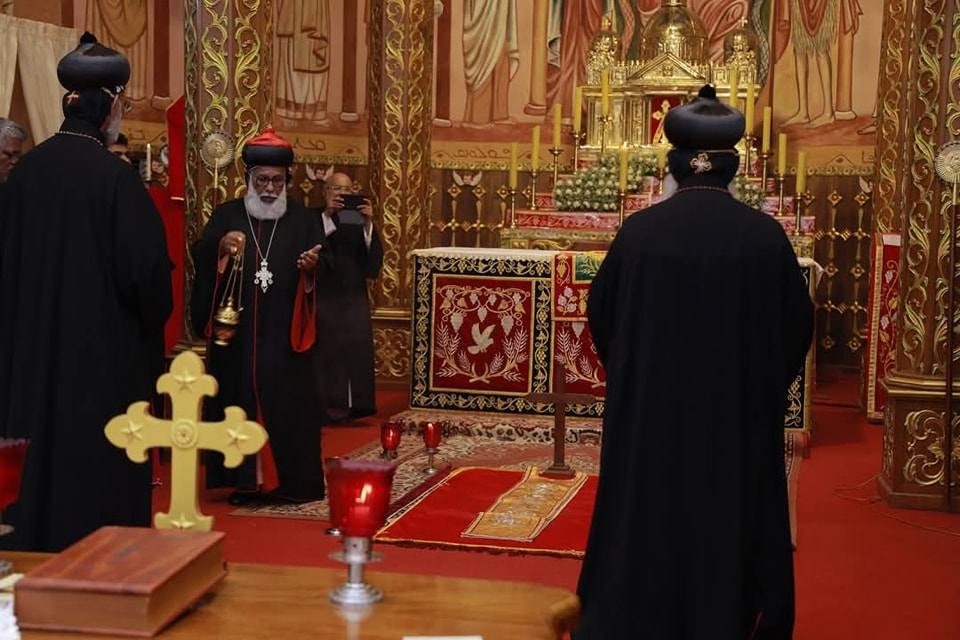
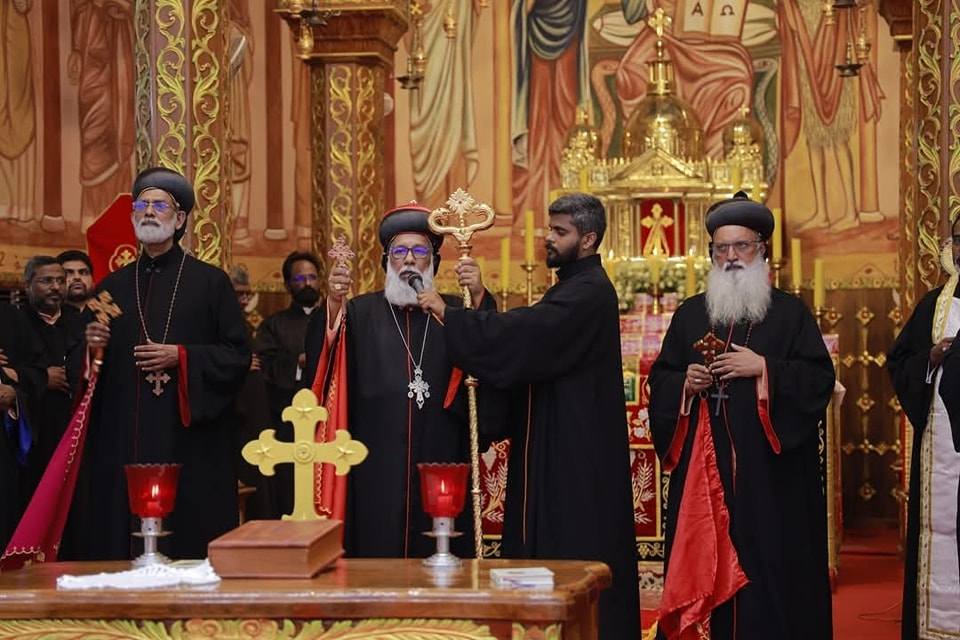
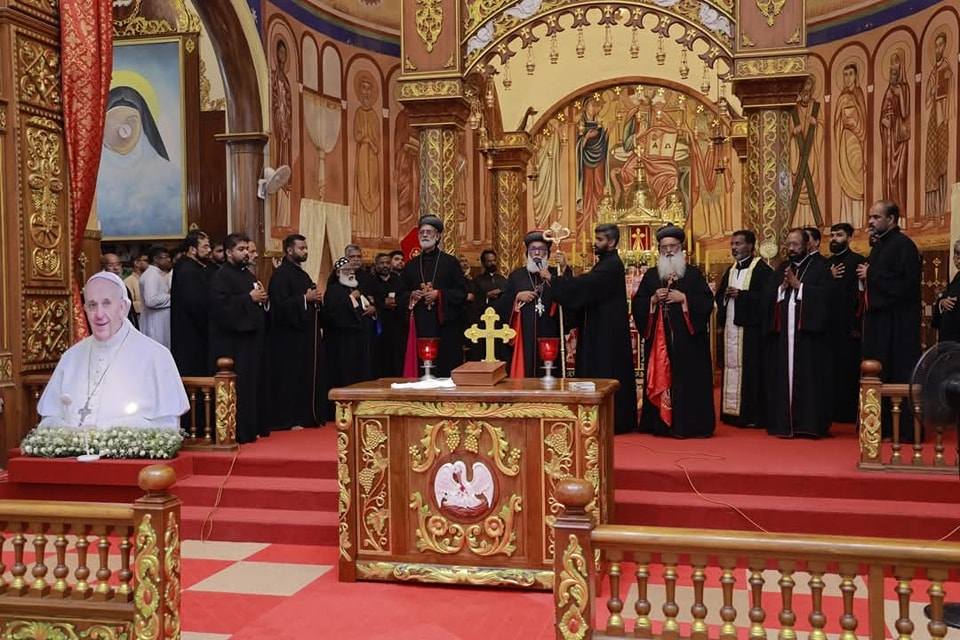
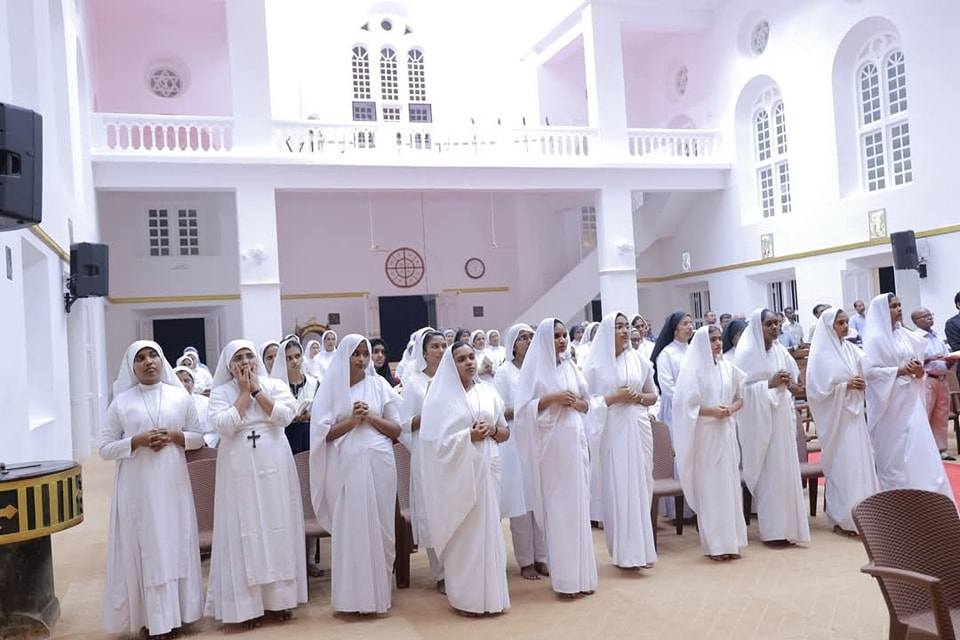
In the quiet hush of St. Mary’s Major Archbishop’s Cathedral, the Mother Church of the Syro-Malankara Catholic Church, incense rose like silent song—a fragrant prayer offered for His Holiness Pope Francis, whose earthly pilgrimage came to a close in Rome.
The incense prayer and memorial was presided over in the sacred presence of His Eminent Beatitude Cardinal Moran Mor Baselios Cleemis Catholicos, Major Archbishop-Catholicos of the Syro-Malankara Catholic Church. This rite of remembrance was not only an expression of mourning, but an act of communion—a solemn unity with the Universal Church, in gratitude for a pontificate shaped by mercy, humility, and bold simplicity.
Joining him in prayer were
- His Excellency Most Rev. Dr. Mathews Mor Polycarpos, Auxiliary Bishop of the Major Archieparchy of Trivandrum
- His Excellency Most Rev. Dr. Mathews Mor Pachomios, Bishop of the Eparchy of St. Ephrem – Khadki – Pune
- numerous priests, religious Sisters, and members of the faithful.
Though the assembly was modest in number, it was deep in spirit—proving that remembrance is not a matter of scale but of love, and prayer its most enduring form.
The altar was simple, yet profound. Outside the iconostasis, a cutout of Pope Francis was placed with reverent care—his familiar, gentle gaze seeming once more to bless the faithful. In that moment, under the dome of Pattom Cathedral, a fragment of Rome was made present—not through artefact or inscription, but through prayer, incense, and the bonds of Catholic communion.
This act was no mere liturgical formality. It was a declaration of fidelity—that we, the Syro-Malankara Catholic Church, rooted in the East yet one with Peter, share in the sorrow and gratitude of the Church Universal. We mourn the death of Pope Francis, but more so, we give thanks for the man who lived the Beatitudes and bore the Gospel in the scent of mercy.
May his memory be eternal.
And may the incense that rose from Pattom be gathered among the prayers of the saints.
The Eighth at Mary’s Feet: Pope Francis to Be Buried at Santa Maria Maggiore
Rome – 22 April 2025
With the humility that marked his life and the clarity that shaped his papacy, Pope Francis will be buried at St. Mary Major Basilica—not beneath the marble splendour of St. Peter’s Basilica, but in the Marian sanctuary that was always close to his heart. In doing so, he becomes the first pope in over 350 years to be laid to rest there, and the Eighth in history.
In December 2023, the Holy Father quietly remarked:
“A place is already prepared.”
Now, that intention becomes reality.
The Basilica of Santa Maria Maggiore, one of Rome’s four major papal basilicas and the oldest church in the West dedicated to the Blessed Virgin Mary, holds within it a lineage of holy shepherds, including:
- Pope Honorius III (d. 1227), who confirmed the Rule of St. Francis
- Pope Nicholas IV (d. 1292), the first Franciscan pope
- St. Pius V (d. 1572), Dominican reformer and defender of the Council of Trent
- Pope Sixtus V (d. 1590), Roman renovator and builder of the Chapel of the Cradle
- Pope Paul V
- Pope Clement VIII (d. 1605), reviser of the Latin Vulgate and friend of St. Philip Neri
- Pope Clement IX (d. 1669), confessor to the poor and beatifier of St. Rose of Lima
Pope Francis, born Jorge Mario Bergoglio, now takes his place in this sacred line—not by honour, but by request. In his 2022 testament, he asked that his mortal remains be placed “in the earth, without particular decoration,” and marked only by the name: Franciscus.
“I have always entrusted my life and my priestly and episcopal ministry to the Mother of Our Lord, Mary Most Holy,” he wrote.
“I wish that my last earthly journey conclude precisely in this ancient Marian sanctuary.”
His burial site lies between the Pauline Chapel, home to the ancient icon of Salus Populi Romani, and the Sforza Chapel, in a modest niche.
While popes since the early 20th century have rested under the Vatican, Pope Francis returns to a more ancient custom—his choice not only rich in symbolism, but deeply personal. He had visited St. Mary Major more than 100 times, often laying flowers before the Madonna before and after every apostolic journey.
The basilica, founded in 432 A.D. following the Council of Ephesus, is steeped in Marian devotion. It is also where the relics of the Holy Cradle—believed to be from Bethlehem—are venerated, and where the great feast of Our Lady of the Snows is celebrated each August.
In this place, beneath mosaics of the Incarnation and under the eyes of the Queen of Peace, Pope Francis will now rest—not far from the faithful he loved, and always within the embrace of the Mother he trusted.
Franciscus and the Madonna: A Pope’s Final Rest at St Mary Major
Rome – 21 April 2025

When popes die, they are buried beneath the splendour of St Peter’s, among their predecessors, under the dome that soars like a lifted prayer. But Pope Francis, in life as in death, declined grandeur for grace.
In accordance with his will, dated 29 June 2022, Pope Francis will be buried not within the Vatican walls, but at the Papal Basilica of Santa Maria Maggiore—a decision that breaks with over a century of tradition. He becomes the first pope since Leo XIII in 1903 to be laid to rest outside the Vatican.
The reason for this request lies not in history, but in devotion.
“I have always entrusted my life and my priestly and episcopal ministry to the Mother of Our Lord, Mary Most Holy,” he wrote in his testament.
“Therefore, I ask that my mortal remains rest… in the Papal Basilica of Santa Maria Maggiore.”
That phrase is more than piety. It is biography.
From the first days of his papacy, Pope Francis was seen often at this fifth-century basilica—built shortly after the Council of Ephesus proclaimed Mary as Theotokos, the Mother of God. The Pope prayed there before and after each of his more than 100 apostolic journeys, always bringing flowers to the image of the Salus Populi Romani. According to Fr. Ivan Ricupero, the basilica’s master of ceremonies, the Pope visited 125 times since his election.
In a passage that reads more like poetry than protocol, Francis asked for his tomb to be prepared between the Pauline Chapel—which houses that revered Marian icon—and the Sforza Chapel, in a niche in the earth, “simple, without particular decoration,” bearing only one word:
Franciscus
There is to be no papal title. No mention of years or glory. Just a name—unadorned, as was his life.
The coffin, too, will reflect this request: a simple wooden casket, departing from the customary triple-nesting coffins made of cypress, lead, and oak. The cost of the burial is being covered by a private benefactor, arranged through Mons. Rolandas Makrickas, Extraordinary Commissioner of the Liberian Basilica.
This Marian sanctuary, some 4 kilometres from the Vatican, has been a haven for the Pope both physically and spiritually. It was here he marked his first public devotion, and now, it is here he has chosen to end his earthly pilgrimage.
“The suffering that has become present in the last part of my life,” he wrote,
“I have offered to the Lord for peace in the world and brotherhood among peoples.”
In this quiet tomb beneath the mother’s gaze, Pope Francis—Franciscus—awaits the Resurrection.
“Franciscus”: The Simplicity of a Pope’s Testament
Vatican City – 21 April 2025
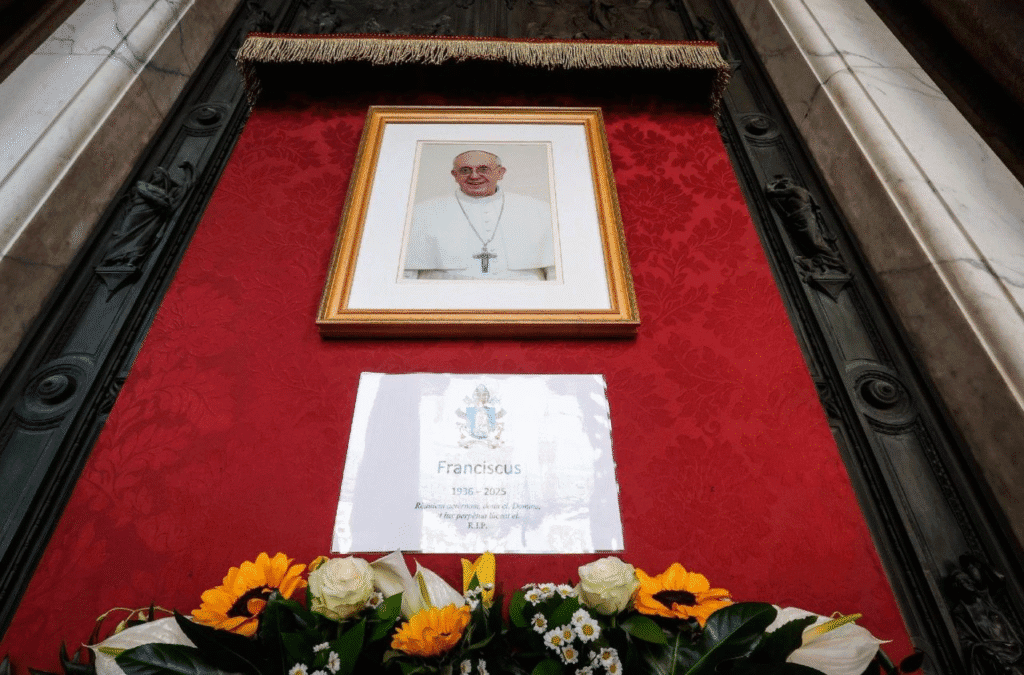
In a Church of pageantry and papal robes, Pope Francis chose, as ever, simplicity. His spiritual testament, dated 29 June 2022—the Solemnity of Saints Peter and Paul—was released by the Holy See, and it reveals a final act of devotion not wrapped in pomp, but in profound humility.
It opens not with biography, nor reflection, but with prayer:
“In the name of the Most Holy Trinity. Amen.”
What follows is not a catalogue of instructions, but one request—quiet and clear. Pope Francis asks that his body, awaiting the Resurrection, be laid to rest in the Papal Basilica of Saint Mary Major, the Marian sanctuary he frequented at the dawn and dusk of every Apostolic Journey. There, before the ancient icon of the Salus Populi Romani, he knelt not as Pope, but as son.
“Throughout my life, and during my ministry as a priest and bishop, I have always entrusted myself to the Mother of Our Lord… For this reason, I ask that my mortal remains rest… in the Papal Basilica of Saint Mary Major.”
No marble canopy. No gilded tomb. Just a simple grave in the ground, marked with a single word: Franciscus.
He even specifies the niche—between the Pauline Chapel and the Sforza Chapel—and arranges for the cost to be borne by a benefactor whose gift was entrusted to Cardinal Rolandas Makrickas, Commissioner of the Liberian Basilica.
There is no farewell in his words, only a quiet benediction:
“May the Lord grant a fitting reward to all those who have loved me and who continue to pray for me.”
And in one final act of priestly offering, Pope Francis writes:
“The suffering that has marked the final part of my life, I offer to the Lord, for peace in the world and for fraternity among peoples.”
Here lies not just a testament of burial, but the essence of a pontificate—one shaped by mercy, marked by Marian devotion, and sealed in silent suffering for the sake of the world.
As the Church prepares for his funeral and the coming conclave, this short testament speaks more loudly than volumes: the heart of a Pope who never ceased to walk with the poor, and who now rests, simply, in the house of the Mother.
Stroke and Heart Collapse: The Medical Report on the Death of Pope Francis
Vatican City – 21 April 2025
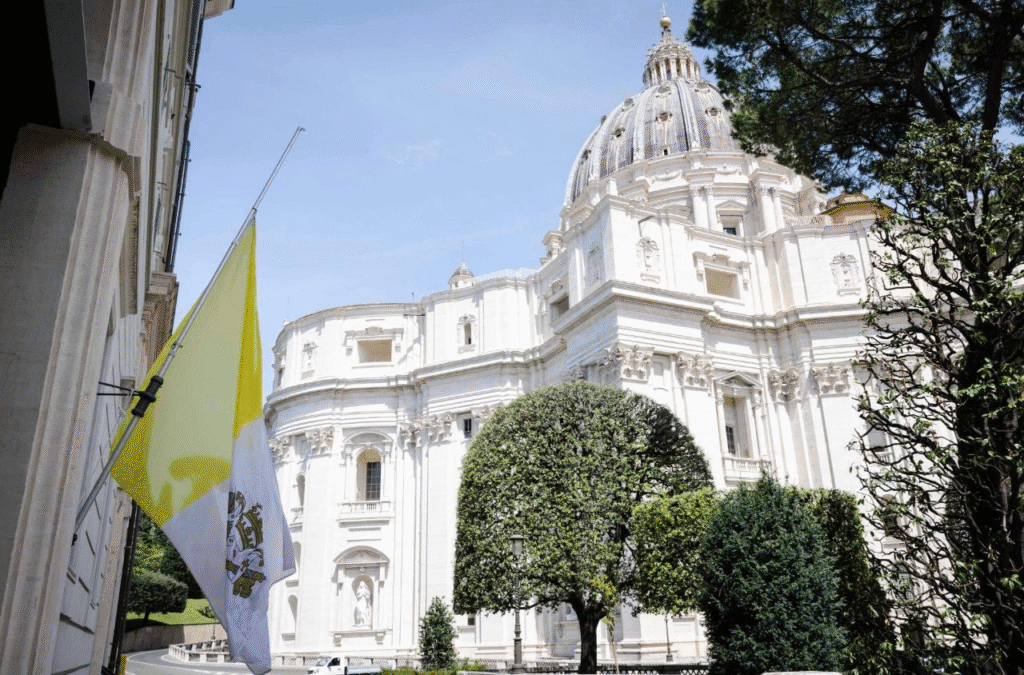
Death arrives without negotiation, but not without grace. On Monday evening, the Holy See Press Office released the official medical report on the passing of Pope Francis, offering the final clinical details of a profoundly human moment.
According to Dr. Andrea Arcangeli, Director of the Directorate of Health and Hygiene of the Vatican City State, the Pope died of a stroke, which led to coma and an irreversible cardiocirculatory collapse. His death was medically confirmed through electrocardiographic thanatography, a solemn tool in the science of finality.
The report outlines a history of acute respiratory failure caused by multimicrobial bilateral pneumonia, multiple bronchiectases, hypertension, and Type II diabetes. All were borne quietly, as was the Pontiff’s way—never drawing attention to his suffering, but instead offering attention to the suffering of others.
In his formal declaration, Dr. Arcangeli stated:
“I hereby declare that the causes of death, to the best of my knowledge and judgment, are as stated above.”
Yet even the most precise statement of medicine cannot measure the mystery of a life handed over to God. Pope Francis, who gave his final public embrace to the faithful just hours before his passing, continued to witness—right to the end—the closeness of Christ to the vulnerable, the poor, and the ill.
As the Universal Church now prepares for his funeral and the sacred rites of mourning, we reflect not only on how he died, but how he lived: simply, humbly, and always in the hope of the Resurrection.
“Thank You for Bringing Me Back to the Square”: Pope Francis’ Final Hours and Last Embrace
Vatican City – 21 April 2025
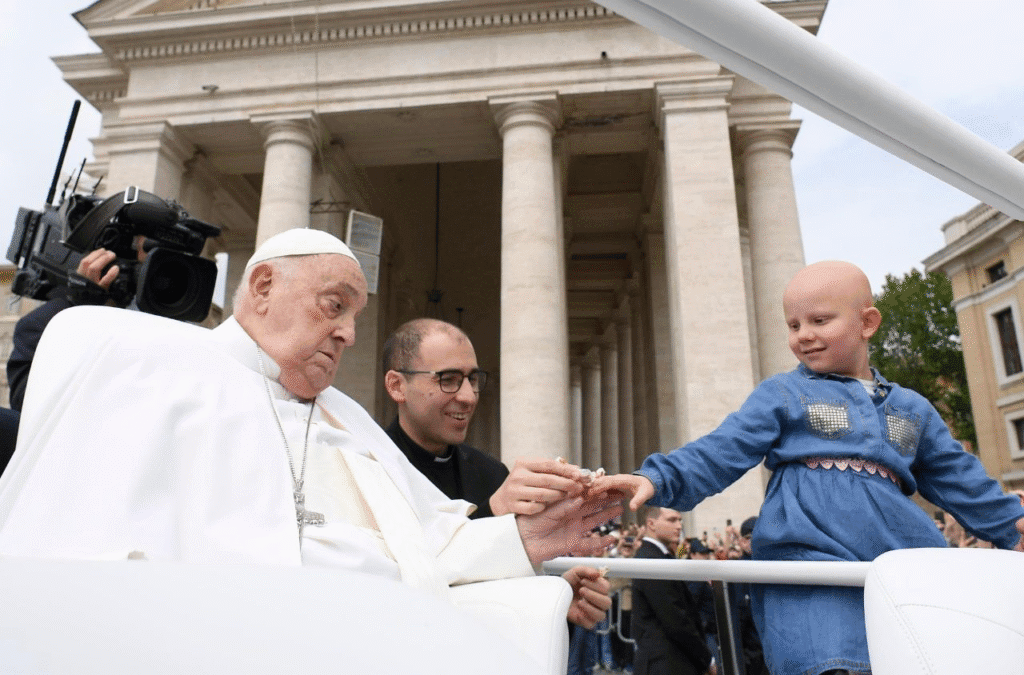
There are saints who die in seclusion, and others who seem to take a final bow—not to applause, but to a multitude of unseen prayers. His Holiness Pope Francis, the Bishop of Rome and shepherd of the Universal Church, breathed his last in the quiet hours of dawn on Monday. Yet, his final words were not theological, nor formal. They were simple. Human. Holy.
“Thank you for bringing me back to the Square.”
These were among the last utterances of Pope Francis, spoken to Massimiliano Strappetti, his devoted personal healthcare assistant, on Easter Sunday—mere hours before his sudden passing. A man of the people until the end, Pope Francis offered one final gesture to the faithful: a surprise ride in the popemobile after imparting the Urbi et Orbi blessing.
He had hesitated, asking Mr. Strappetti quietly, “Do you think I can manage it?”—a question that carried both humility and courage. And then, through the arms of 50,000 faithful gathered in St. Peter’s Square, he passed once more, waving, blessing, and—most especially—embracing children, his countenance weary, but filled with a quiet joy.
This was to be his last public appearance.
That evening, he dined simply and rested. At 5:30 AM Vatican Time (9:00 AM IST) the next morning, he suddenly fell ill. Within the hour, as those at his bedside responded in haste, he offered a faint wave of farewell to Mr. Strappetti—and then fell into a coma. It was a swift, peaceful passing: a hidden death for a man who had always borne his frailty without spectacle.
It was the day after Easter. His final blessing had already been given. His last ride among the faithful had been completed. And his last “thank you” had not been to a cardinal or a dignitary—but to the man who had stood beside him in illness, and who helped him return, one last time, to the embrace of the Church in the Square.
For us in the Syro-Malankara Catholic Church, this moment echoes with resonance. From Thiruvananthapuram to Tiruvalla, from Mavelikara to Marthandam, our Church joins in mourning with the Universal Church. The final days of Pope Francis, filled with silent suffering and quiet joy, remind us of the strength that lies in simplicity—the strength that shaped his papacy and now adorns his passing.
Let us remember him in our Holy Qurbanas, in our incense prayers, and in our gatherings across our Ecclesiastical Districts.
May the servant of God, Pope Francis, now rest in the presence of the Shepherd he followed with love.
